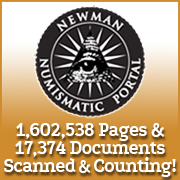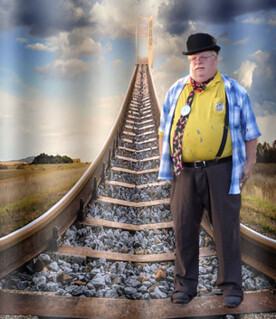
About UsThe Numismatic Bibliomania Society is a non-profit organization devoted to the study and enjoyment of numismatic literature. For more information please see our web site at coinbooks.org SubscriptionsThose wishing to become new E-Sylum subscribers (or wishing to Unsubscribe) can go to the following web page link MembershipThere is a membership application available on the web site Membership Application To join, print the application and return it with your check to the address printed on the application. Print/Digital membership is $40 to addresses in the U.S., and $60 elsewhere. A digital-only membership is available for $25. For those without web access, write to: Terry White, Treasurer AsylumFor Asylum mailing address changes and other membership questions, contact Terry at this email address: terrywhite5475@yahoo.com SubmissionsTo submit items for publication in The E-Sylum, just Reply to this message, or write to the Editor at this address: whomren@gmail.com BUY THE BOOK BEFORE THE COINSale Calendar |
- WAYNE'S WORDS: THE E-SYLUM DECEMBER 6, 2017
- EPNNES DONATIONS TO NUMISMATIC ORGANIZATIONS
- KOLBE & FANNING BUY OR BID SALE NUMBER 5
- NEW BOOK: LIBERTY SEATED DOLLARS
- DIRTY OLD BOOKS: CRAIG’S GERMANIC COINAGES
- ARCHIE TAYLOR, JR. (1951-2017)
- RUTH HILL INVENTORY ADDED TO NEWMAN PORTAL
- NEWMAN PORTAL SEARCH: 101 RANCH
- WORLD NUMISMATICS ON THE NEWMAN PORTAL
- JOEL ISKOWITZ AND NARRATIVE ART ON U.S. COINAGE
- MORE ON THE DELAWARE TERCENTENARY MEDAL
- NOTES FROM E-SYLUM READERS: DECEMBER 3, 2017
- THE 1818 “I OVER 0” REVERSE HALF EAGLE
- MEDAL-ENGRAVING MACHINES AND ANAGLYPTOGRAPY
- VOCABULARY TERM: ANAGLYPTOGRAPHY
- ALBERT FORREST MOSIER (1866-1892)
- THE BELA LYON PRATT SESQUICENTENNIAL
- BOB LEONARD'S NUMISMATIC MEDITERRANEAN CRUISE
- COINAGE PRESSES AND THE ENGINEER’S THUMB
- ALEX SHAGIN’S SHERLOCK HOLMES MEDALS
- WSJ HIGHLIGHTS MINT'S PROOF COIN MARKUP
- 1913 LIBERTY NICKEL HOLDER BRINGS $10,800
- ROMAN SERRATED DENARII
- THE 1868 CYRUS FIELD CONGRESSIONAL GOLD MEDAL
- SWAZILAND COINS STAND IN FOR POUNDS
- BANKNOTE OF THE YEAR NOMINEES
- THE TWO DOLLAR BILL BOOK
- NEW BOOK: THE MEDIEVAL GIRDLE BOOK
- GOLD COIN HOARD FOUND IN FOOD DONATION
- HAVE A NUMISMATIC CHRISTMAS
- FEATURED WEB PAGE: OAK SAPLING ON GERMAN COINS
Click here to access the complete archive
To comment or submit articles, reply to whomren@gmail.com
Content presented in The E-Sylum is not necessarily researched or independently fact-checked, and views expressed do not necessarily represent those of the Numismatic Bibliomania Society.
WAYNE'S WORDS: THE E-SYLUM DECEMBER 6, 2017
This week we open with a note on the Eric P. Newman Numismatic Education Society donations to numismatic organizations, Kolbe & Fanning's latest numismatic literature buy or bid sale, one new book and a review of an old one: Craig's Germanic Coinages.
Other topics this week include Archie Taylor, Ruth Hill, Joel Iskowitz, Alex Shagin, Bela Lyon Pratt, the 1818 "I over O" reverse half eagle, the 1913 Liberty Nickel case, medal-engraving machines and anaglyptograpy.
To learn more about roman serrated denarii, the 1868 Cyrus Field medal, Liberty Seated Dollar die varieties, Stack’s Numismatic Review, challenge coins, Bob Leonard's numismatic Mediterranean cruise, the pronking springbok, the Dingle Penny, the 101 Ranch, and the two-dollarbill book, read on. Have a great week, everyone!
Wayne Homren
Editor, The E-Sylum
EPNNES DONATIONS TO NUMISMATIC ORGANIZATIONS
EPNNES Thanksgiving Donations to Numismatic Organizations
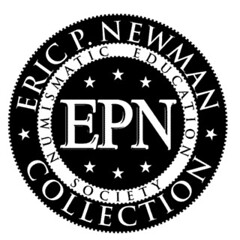 In the spirit of Thanksgiving and to honor the field that was a life-long source of joy and discovery for Eric P. Newman, the Eric P. Newman Numismatic Education Society (EPNNES) is making
a number of one-time gifts to organizations dedicated to the study and promotion of numismatics.
In the spirit of Thanksgiving and to honor the field that was a life-long source of joy and discovery for Eric P. Newman, the Eric P. Newman Numismatic Education Society (EPNNES) is making
a number of one-time gifts to organizations dedicated to the study and promotion of numismatics.
EPNNES desires to acknowledge the work of various national, regional, and specialty groups and to further encourage the pursuit of scholarship and collaboration. Newman was active in many numismatic societies throughout his long collecting career and understood the value of working with fellow collectors and researchers in order to advance the science of numismatics.
EPNNES particularly wishes to recognize groups that have freely shared information with the wider numismatic community. Organizations receiving gifts will be contacted directly by EPNNES in the coming weeks.
KOLBE & FANNING BUY OR BID SALE NUMBER 5
Kolbe & Fanning Announce Buy or Bid Sale #5 Through December 11
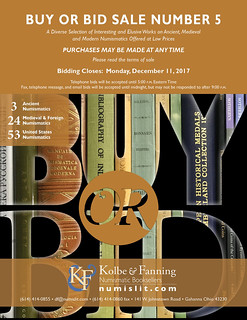 Kolbe & Fanning Numismatic Booksellers have announced their fifth “Buy or Bid Sale,” which begins now and will close on Monday, December 11. The sale focuses on modestly priced books,
giving collectors an opportunity to add to their libraries at minimal cost.
Kolbe & Fanning Numismatic Booksellers have announced their fifth “Buy or Bid Sale,” which begins now and will close on Monday, December 11. The sale focuses on modestly priced books,
giving collectors an opportunity to add to their libraries at minimal cost.
There will be no printed catalogue. The PDF catalogue is available now for downloading from the Kolbe & Fanning website at numislit.com.
As the name of the sale suggests, customers may bid on items they wish to acquire or buy them outright at the published price. The Terms of Sale will give full instructions on how to participate: please read it carefully.
The sale includes over 1400 works on ancient, medieval and modern coins, as well as general works, periodicals and sale catalogues. “Buy” prices have been kept low to promote sales. To further encourage participation, the firm is offering free domestic shipping to bidders spending at least $500; there will also be no packing and processing fee for this sale. Again, please read the Terms of Sale before participating.
If you have any questions about the sale, please write the firm at orders@numislit.com.
Thank you in advance for your participation. Download the sale today: numislit.com.
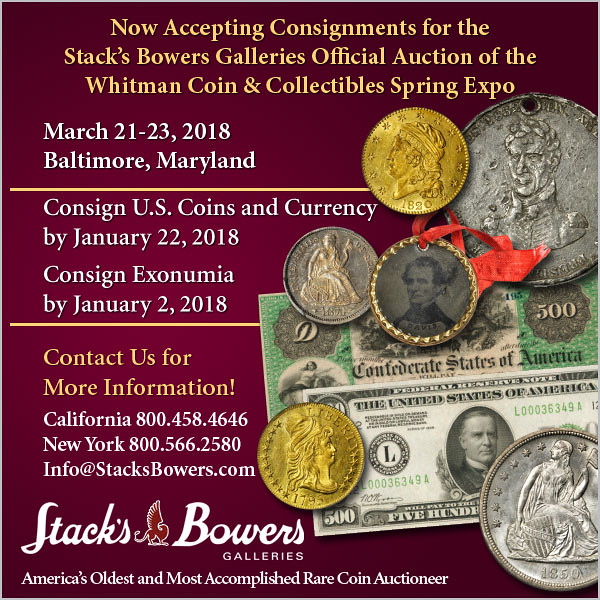
NEW BOOK: LIBERTY SEATED DOLLARS
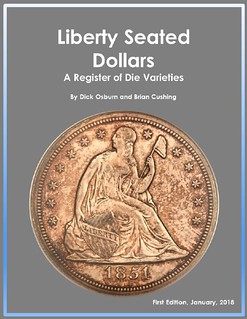 Liberty Seated Dollars
Liberty Seated Dollars
A Register of Die Varieties
By Dick Osburn and Brian Cushing
Dick Osburn and Brian Cushing announce the release of their new book on Liberty Seated Dollars. The book will be formally released at the Florida United Numismatists (FUN) winter convention in Tampa, Florida. The show begins on Wednesday, January 3, and ends on Sunday, January 7. Dick and Brian will be signing the book at their table – Dick Osburn Rare Coins.
The book covers all Liberty Seated dollars, beginning in 1840 and ending in 1873. Both business strikes and proofs are included. All known die marriages of each issue are described in detail, with estimated rarity ratings for each die marriage. Each issue is described in a separate chapter, a total of 48 chapters for the series. Also included are chapters on Terminology, Collecting Liberty Seated Halves, Grading, Rarity, Survival Rates and Population Estimates, Proofs vs. Business Strikes, and Restrikes. A Top-30 list of varieties is described in another chapter.
Pre-publication prices (prior to January 1, 2018):’
Spiral bound: $85.00
Hard-bound (limited edition): $115.00
Loose-leaf, punched for a 3-hole binder: $80.00
Post-publication prices (beginning January 1, 2018):’
Spiral bound: $95.00
Hard-bound: $129.00
Loose-leaf: $85.00
Send check or money order to:
Dick Osburn
Box 596
Kemah, TX 77565
For more information on the new book please contact:
Dick Osburn
713-875-5860
dickosburn@comcast.net
Brian Cushing
603-767-7745
bpcushing@gmail.com
DIRTY OLD BOOKS: CRAIG’S GERMANIC COINAGES
I recall that many years ago I either heard someone say, or saw in print somewhere ‘there is nothing so fascinating as an old newspaper’; to which you might add ‘and old books’.
We are still processing for sale the books that we bought, a long while ago, from the library of Professor Philip Grierson. There are many treasures, and already a pile of books that will go no further than our own library, though there are many more that we hope will find new owners to cherish them. For me, there is always a little frisson of delight when I use a book that has belonged at some time to a numismatist of note, especially those I have known, or with whom I have corresponded.
One of the old books that has come to light is a copy of William D Craig’s Germanic Coinages, a remarkable work which was published in 1954 and is still useful today.
But let me take you back to 1954. Here in the UK, although the war was over and rationing had just finished, there was still general austerity and goods although no longer rationed by law, were rationed by price. Just after the war in Europe, we did not have what is now termed a refugee problem, in those days they were called ‘displaced persons’. Factory workers worked a 48-hour week and £10 for a week’s work was a reasonably good wage.
Our house had an electricity supply, hot and cold running water and an indoor toilet, you might say we were flush, certainly, we were compared to my maternal grandfather whose home was lit by gas and candles, and his water supply was cold water only. His sanitation was an outdoor earth and ashes closet.
Television, black and white, of course, was beginning to become available, though you had to be relatively well off to afford a set. A great deal of effort had been made the previous year, 1953, to make it available here in Wales so that people could view the coronation as it happened. We didn’t have a set, so my family, who had the day off for the big event, walked five minutes down the street, to the house of my uncle Alfred’s father, a retired pensioner from the Boer war. His many children had clubbed together to buy the television set for him, the biggest and best available. He was a lovely old chap and he and his wife had a large number of children now all grown up. He had come back from the Boer war in South Africa in 1901 and returned to mining, only to have an accident that precluded him from taking part in the next conflict. He smoked a pipe, the smell of which I loved. He wore a waistcoat, with four pockets that seemed always to have something interesting for his numerous grandchildren, and he seemed not to worry that I wasn’t directly related to him, I lived in the same street and one of his sons was married to my mother’s sister.
To a young child his waistcoat pockets seemed truly magic, there were always wrapped sweets, real treasures in the days when they were rationed, but his wife had a shop and presumably sources for buying such goodies, although I suspect now that these were black market. Another pocket housed a large gold watch, which was on the end of a double Albert, from the other end of which there dangled a seal, which rotated, and a coin, not an ordinary sovereign, but an ‘oom’ Paul Kruger pond, which he had brought back from South Africa when the war ended. He explained that Oom (“Uncle”) Paul was president of the Transvaal, or South African Republic, from 1883 until his flight to Europe when the South African (Boer) war broke out. It was June 2nd, 1953 and I was proudly wearing the new black blazer, onto which my mother had sewn the badge of the town grammar school, for which I had passed what was in those days called ‘the scholarship’.
That morning, or perhaps the day before, we had heard a radio announcement that Mount Everest had been climbed by a British team including Edmund Hilary, who was almost immediately knighted for his efforts, never mind the fact that it was his Sherpa guide Tensing who was the first to the summit ! India, and much of the rest of the world was still part of the glorious British Empire and the Dominions beyond the Sea. What a triumph for coronation day !
Although my parents didn’t have a television set, entertainment was available several nights per week if we took a bus ride to one of the town’s four cinemas just a mile or two away, and if we walked home instead of taking the bus, we could afford a fish and chip supper from a shop that we passed on the way. That year we were even going on holiday to stay with my father’s aunt Clara, in Worcester. All was well in the world.
I didn’t know it, but far away, in California, where another of my father’s aunts lived, William D Craig, a lawyer, then in his early 30s, was about to publish Germanic Coinages.
My British-born American great aunt Beat(rice), after whom my father’s sister was named, in the hope of a legacy, was something of a legend in our family. She sent us food and other parcels during the war, one of which I remember particularly well, contained a cowboy doll with leather leggings, with which I was not allowed to play because I might get it dirty. This didn’t worry me unduly because I had a panda, which I much preferred, because whilst I could cuddle a cute little panda, I certainly didn’t want to cuddle a cowboy, with or without leggings, even if he did have a gun. Great aunt B evidently didn’t go in for much cuddling either, for her husband was never mentioned. However, she must have been rich because she not only had a car, which she could drive, she had a pilot’s licence, and could and did fly small aircraft to ferry her boss around, amazing to a small boy who lived in a tiny town where vehicles were often still horse-drawn, and until relatively recently the appearance of aircraft was preceded by sirens warning us to take shelter before the bombs fell.
However, back to Craig, who was born in the USA around 1920. He became an attorney, but his passion was not the law, but German coins. In 1954, he published Germanic Coinages (Charlemagne through Wilhelm II), which became the standard reference in the field. The Galata website has the following description of the book:
William D Craig. Published by the author, Mountain View, California, USA. HB (linen cloth) viii + 242 pages, illustrated with several hundred line drawings. With separate 16 page stapled supplement, and duplicated instruction slip on how to use it. 172 x 248mm.
So what distinguishes this from other books published at the time and a great many that have been produced since ?
Here is part of the author’s preface, which tells us some of the story. He says:
“This book has been compiled to meet what I have long considered an urgent necessity. The field of German numismatics, often termed "the greatest speciality," has been almost neglected outside Germany itself because of the difficulty and expense encountered by novices attempting to attribute their first German coins. One could readily purchase publications on the currency of Greece, Rome, Latin America or Britain for a small sum, but a decent-sized library has been required to even begin with Central Europe. Since most collectors are loathe to acquire reference libraries disproportionately more valuable than the coins they describe, interest in the German series has lagged. To alter this situation, some sort of general catalog has been badly needed. However, in view of the several hundred thousand coins involved, any attempt to compile even a list of major types was destined to economic failure. As a substitute, numerous experts have written catalogs limited to the monies of individual states. Other catalogers have listed the contents of large public and private collections in Europe. Still others, like J W Scott, Eklund, and Professor Davenport, have compiled more or less complete lists of certain coin types such as coppers or thalers. Thus the field has been covered in vertical and horizontal cross section, as well as by the scatter-shot method, but no one has produced a reference work which, by itself, could be used to attribute the majority of German coins the ordinary collector is likely to encounter. This handbook is my effort in that direction. In addition to outlining the realm of German numismatics for the beginner, this work is designed as a source of basic information for the advanced student and dealer. It should prove invaluable as an aid to rapid and complete attribution of large lots.”
In short, this is a serious, considered and well-thought-out work, the like of which had not been published before. It was the book that Craig needed when he started to collect Germanic coinages. Along with the works of Dalton & Hamer, Charles W Peck, it goes onto my list of the top ten books that ought to form part of every numismatic library.
He continues: “As shown in the Table of Contents which follows, the present volume contains, at least in sketchy fashion, data on nearly every factor useful in identifying Central European coinage.”
The contents of those chapters are as follows:- 1. A Simple Guide to Heraldry. II. German Armorial Devices. III. The German States: History and Rulers. IV. General Monetary History of Germany. V. Mints and Mintmarks. VI. Glossary of Monetary Units and Terms. There are appendices:- A. Rulers' Monograms Identified. B. Patron Saints Identified. C. Counterstamps Found on German Coins. D. Place Names. E. Translations of German and Latin Titles. F. Table of Coin Denominations. Its worst defects, as the author admits, are (1) insufficient information to attribute more than a portion of German medieval currency, and (2) the absence of lists of mintmarks. “These have been eliminated perforce due to space considerations.
Coins of the Middle Ages are best identified through familiarity based on experience. The next best means is through the lavish use of photographs. These are quite costly, and since beginners rarely obtain unattributed medieval currency, pictures are not a sound investment here. Mintmarks are often highly useful as an aid to attribution, but inclusion of a reasonably complete list of them would double the size of the present volume. Consequently, it is suggested that anyone interested in this phase of German numismatics consult Leonard Forrer's monumental work, A Biographical Dictionary of Medallists, published in London during the early part of the century.”
What Craig does not tell us is the real reason why there is no German book on German coins written by a native-born German. Personally, I have always thought that it was a slur on Germany that the standard reference on German coins was written by an American. However, most Germans collect only the coins of their own state or region of Germany prior to 1874, the coins of United Germany from 1874, or some collect the coins of the 3rd Reich, or those of the DDR, or modern Germany. Nowadays some collect only the euro coinage issued in Germany – but then there have always been collectors with no imagination.
The current situation regarding the availability of the fundamental works on German coins has not changed greatly. A fair number of the important ones were reprinted back in the 1950s to commemorate the centenary of their original publication. Wonderful, but many of them were self-defeating for they were often printed only in the same numbers as the original printing, usually only a hundred or so, and are also now long out of print, difficult to find and rather costly, or both ! Worse still they are (obviously) in German and the majority of Americans, like the largely monoglot English, suffer from that compound of arrogance, ignorance and insularity that makes them believe that everyone should speak English because it’s a superior tongue to all others.
For this reason, this wonderful book is just as valuable now as it was back in 1954 and just as necessary for the thinking collector of Germanic coinage, even those who live in Germany. Whilst writing this I discovered, through the marvels of the internet, that in 1966, Craig upped- sticks and moved to Hobart, Tasmania. Here he discovered a new passion - philately. Over thirty years he compiled, edited and published nine comprehensive catalogues of British Commonwealth and Australian States revenue stamps. The first, on Tasmania, appeared in 1978; the last, for Victoria, in 1999. The most recent update of which was issued in 2002. According to the internet source, each of his catalogues is a scholarly work including newly researched information that had not been published previously. Like ‘Germanic Coinage’ these were published privately by Craig himself. Why did he do that ? Because, particularly in the USA, the nature of the mass numismatic market is such that only those books that are cheap and cater for the masses, will succeed. Any that are specialist, different from the norm, investigative, designed for the thinking person, are destined never to make it make it to the top of any popularity poll, for everything is governed by price – a sure way to replace quality and excellence with mediocrity.
Even more astonishing is that I could not find an obituary for Craig, so perhaps he is still alive, nearly a century old and living quietly in the obscurity of a retirement home. Regardless of whether he is, or not, I salute him, his spirit is still alive through his books. He inspired me to publish under the Galata imprint numismatic books that I and others write on subjects that deserve to be adequately researched and there are still corners of the numismatic world that need illuminating, so I go on writing and publishing.
My own comment on this work is ‘A most informative and useful book.’ Suitable for a somewhat reserved listing of secondhand and antiquarian books. However one of my original comments on the condition of one of the copies that we have for sale, which said ‘Dirty cover, but contents good’ had to be changed before it sold. Are present-day buyers of books totally lacking in humour ?
To visit the Galata web site, see:
https://www.galata.co.uk/
Today at a highly respectable 95 he resides in a nursing home on the Aussie mainland. His collection will comprise a major segment of Downies sale 317 on July 8-10 to be held in their Block Arcade auction rooms, 98–100 Elizabeth Street, Melbourne. The catalog for this sale is currently being compiled. Interested readers wanting details will need to keep a weather eye on the Downies website: www.downies.com/aca.
To read the complete article, see:
DOWNIES TO SELL WILLIAM D. CRAIG COLLECTION (http://www.coinbooks.org/esylum_v17n10a09.html)
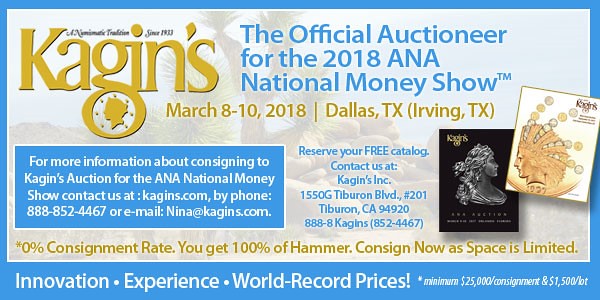
ARCHIE TAYLOR, JR. (1951-2017)
It was at the January show in Fort Lauderdale that we began to hear that Archie had some medical issues and the news just got worse when he was diagnosed with cancer. Sadly he lost the battle and passed away on October 5th . Many of you probably already have heard by now.
Wanda let me know that Archie was cremated in his yellow shirt and bowler hat. He wanted no fanfare, no viewing, no special ceremonies, and his only request was to have his ashes spread at his hobo camp at River Ranch in FL. While he was ill he spent much time there and enjoyed it greatly. There he was removed from all the detrimental germs while his body was in a weakened state from chemo and he was living out a life akin to a real hobo in his jungle camp.
Just weeks before his passing, OHNS was at work setting up a scholarship fund in Archie’s name. Archie had two passions, working with kids and helping modern carvers just getting started. Since there is already a modern carver honorarium, we felt a fund to help YNs would best reflect Archie’s spirit and goals. OHNS has organized a scholarship for higher education and will award between $500 and $1000 a year depending on what the budget will allow. There will be more details on this in the Spring issue of BoTales.
Once we got the call that Archie had “taken the westbound”, we got to work with one last tribute and that was securing a full page ad in The Numismatist (an ANA publication) for a memorial tribute. This again required finding funds to make it happen. Between officers, board members, carvers, OHNS members, OHNS Facebook, and even a check from Archie’s family, we succeeded. These ads are few and far between, mainly due to cost (over a grand) and are reserved for important numismatists with many followers funding such an ad.
Archie was touched by how many people cared for him and I think he was one of the lucky ones knowing what he meant to people before his death. He had a great outpouring of support both monetarily and emotionally during his battle with cancer. Archie my friend, you will be missed.
For more information about the Original Hobo Nickel Society, see:
http://www.hobonickels.org/
RUTH HILL INVENTORY ADDED TO NEWMAN PORTAL
The latest addition to the Newman Portal is the inventory of the Ruth Hill world paper money collection. Including thousands of notes, the handwritten inventory is divided into 43 parts, covering nearly every country in the world, from Afghanistan to Zimbabwe.
Hill (1898-1995) was a St. Louis collector who lived close to Newman, and the two corresponded on various aspects of paper money. She served as president of the International Bank Note Society from 1979-1981. The Hill collection was sold in 2014 by Heritage, who recognized her as the “Grand Old Lady of Paper Money Collecting in North America.”
Link to Ruth Hill inventory on Newman Portal:
https://nnp.wustl.edu/library/archivedetail/523209
Link to Ruth Hill / Eric Newman correspondence on Newman Portal:
https://nnp.wustl.edu/library/archivedetail/515378
To read earlier E-Sylum articles about Ruth Hill, see:
QUERY: WHERE IS THE RUTH HILL WORLD PAPER MONEY COLLECTION? (http://www.coinbooks.org/esylum_v16n07a16.html)
MORE ON RUTH HILL (http://www.coinbooks.org/esylum_v17n07a13.html)
MORE ON THE RUTH HILL WORLD BANKNOTE COLLECTION (http://www.coinbooks.org/esylum_v16n08a07.html)
NEWMAN PORTAL SEARCH: 101 RANCH
A user this week searched for “101 Ranch.” This brought to mind a college trip cruising the 101 highway in California, a coastal route with spectacular scenery. A quick search of the Newman Portal suggests I’d be a sure loser on Numismatic Jeopardy. The October 1969 issue of Bunyan’s Chips, journal of the International Order of Wooden Money Collectors, identified a set of wooden nickels featuring the “101 Ranch Rodeo” and commemorating the 75th anniversary of Ponca City, OK. Elsewhere, in the 1981 TAMS Journal, former ANA Executive Director Ed Rochette placed a want ad for “101 Ranch” scrip. A Johnson and Jensen auction sale catalog, 1980, cataloged a “101 Ranch” medal (lot 71) as follows:

101 Ranch Centennial Medal, 1976: 1 1/2-inch (38.2mm) copper. By Frank Hagel, stc. Obv. Trapper with long rifle. Rev. prospector panning for gold. Struck by Medallic Art Co. (72-45-5).
This all tells us there are a number of numismatic objects associated with the “101 Ranch” but still don’t tell us what it is. That is answered in the Stack’s Bowers catalog of February 2016, lot 35, an 1899 $5 silver certificate, which writes in part,
“….These bills circulated in an era when the Wild West was a prevailing theme in entertainment. Throughout America many traveling shows featured cowboys, Indians, horses, cattle, bison hides and other trappings. Perhaps the most successful was the 101 Ranch, headquartered in Bliss, Oklahoma, with a large traveling entourage that played in many towns and cities.”
Link to Bunyan’s Chips, October 1969
https://nnp.wustl.edu/library/book/521351?page=87
Link to TAMS Journal 1981, no. 6
https://nnp.wustl.edu/library/book/525590?page=24
Link to Johnson & Jensen Auction 6:
https://nnp.wustl.edu/library/auctionlots?AucCoId=511036&AuctionId=518012&page=3
Link to Stack’s Bowers February 2016 Rarities Sale:
https://nnp.wustl.edu/library/auctionlots?AucCoId=3&AuctionId=517088&page=62
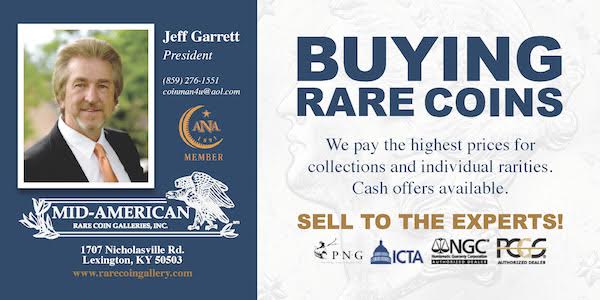
WORLD NUMISMATICS ON THE NEWMAN PORTAL
The Portal Opens #3 (John Kraljevich)
The Newman Numismatic Portal has followed Eric Newman’s lead down the back roads of numismatics. Banking history, obscure auction houses, letters written to numismatists now shrouded by the fog of obscurity: it all finds equal footing here with the classic periodicals, catalogues, and reference works we all know and love. While Eric collected U.S. Federal coins, and was a pioneering researcher in fields as diverse as colonial coins and obsolete bank notes, his fields of study were not solely limited to the North American continent.
And thus, neither is the Newman Numismatic Portal.
Eric was among the first American numismatists to champion the importance of world coins that circulated in early America, from the counterfeit halfpence he researched so avidly to the Latin American coins that set the stage for our dollars and dimes. His membership in the Royal Numismatic Society remains an unusual honor for an American, even as his abiding love of British numismatics has become more common among his American countrymen.
Fortunately, researchers in wildly diverse fields of world numismatics will find abundant resources here. For now, most of the texts included on the Portal are written in English. We imagine that will not always be the case, and would love assistance identifying and sourcing important works in other languages. But even with the language restriction, NNP can help just about any research project.
Among the great treasures of the NNP’s collection of periodicals is the publication of Numismatics International, listed as the NI Bulletin. Founded in 1964, the organization is devoted solely to non-US coins. A perusal of the Bulletin’s pages yields original research on coins from every inhabited continent. Much of John S. Davenport’s research on European crowns appeared here first. Latin American specialists will find original research by Jorge Proctor, Herman Blanton, Frank Sedwick, and others, from technical treatises on die varieties to mint history. Aspects of Islamic and ancient numismatics are covered with depth and excellence. The NNP collection includes every issue from 1966 to 2015. If any field of world numismatics tempts your interest, you will find research relevant to your specialty.
Though short-lived, Stack’s Numismatic Review (filed under N) also included original research from some of the brightest minds in the field. From 1943 to 1947, the Numismatic Review rivaled the old AJN for scholarship. Ancient coins, modern issues, world medals, and Latin American numismatics are all covered with excellent brief articles on subjects that stretch from the fascinating (“An Abortive Attempt to Establish a Mexican Mint in San Francisco” by A.F. Pradeau, December 1943) to the, well, relatively obscure (“The Bread Tokens of Hildesheim”).
Then again, maybe you’re really into bread tokens. A search for “bread token” yields 184 hits on the NNP. Of those, 58 hits are among periodicals. Mehl’s Numismatic Monthly reveals that David Proskey exhibited a bread token of Elberfeld at the March 1917 meeting of the New York Numismatic Club. In a similar vein, Mr. Lionel L. Fletcher displayed “a break token of 1729, with reverse ‘POORE’” at the January 1930 meeting of the British Numismatic Society, as recounted in the British Numismatic Journal. Fletcher also kindly shared his “Dingle Penny of 1679.” The “Dingle Penny” was referenced by John Kleeberg in his 1992 Coinage of the Americas Conference paper on the New Yorke in America token, brought up for its similar and contemporaneous depiction of Cupid shooting an arrow at two young lovers beneath a tree.
Whether you’re into Dingle tokens, or the eight escudos of Ecuador (check out the musings and auction catalogue descriptions of Henry and William Christensen, if so), or the coins of the procurators of Judea (covered regularly in The Augur, published by the Biblical Numismatic Society from 1977 to 1983), the NNP covers much more than the coins, medals, and paper money of the United States. Go explore. You might learn something.
To read the complete article, see:
The Portal Opens #3 (John Kraljevich) (https://nnp.wustl.edu/blog-post/515151)
JOEL ISKOWITZ AND NARRATIVE ART ON U.S. COINAGE
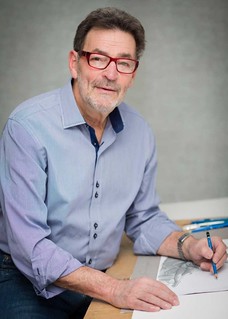 Reflecting on his work with coinage during a 2015 interview, Joel Iskowitz said, “it’s very gratifying to think that my art work has such wide reach, though a majority don’t know who I am
and don’t even know that it’s an artist that creates these miniature works of art.” This quotation reveals a great deal about the philosophy of a man who is a giant figure in the creation of recent
American coinage, even if he is known only to a small numismatic circle. Designing coinage, he attests, is a high honor, and coins must be of the highest artistic quality.
Reflecting on his work with coinage during a 2015 interview, Joel Iskowitz said, “it’s very gratifying to think that my art work has such wide reach, though a majority don’t know who I am
and don’t even know that it’s an artist that creates these miniature works of art.” This quotation reveals a great deal about the philosophy of a man who is a giant figure in the creation of recent
American coinage, even if he is known only to a small numismatic circle. Designing coinage, he attests, is a high honor, and coins must be of the highest artistic quality.
Joel Iskowitz joined the U.S. Mint’s Artistic Infusion Program as a designer in 2005. Having created over 50 U.S. coinage and medal designs issued in the last decade, he is the most prolific U.S. coinage designer of the recent era. Iskowitz had a long career as an artist before entering numismatics. Beginning in the 1970’s as an illustrator, he created album covers and postage stamps—over 2,000 designs for 40 countries. He had also completed work for NASA and the Air Force Art Program.
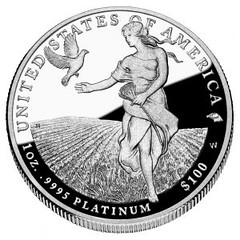
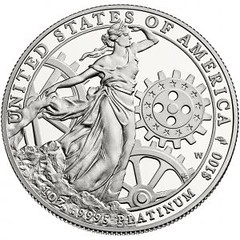
Right: 2013 American Eagle Platinum One Ounce Proof Coin Reverse
Iskowitz is a realist narrative artist. The function of his art, he stated during a 2014 symposium, is “to distill and advance the [subject’s] story.” To achieve this, he relies on a detailed process. He begins all his numismatic work in the same way: by reading and re-reading the authorizing Congressional legislation. He seeks to understand and internalize the rationale why an honor is being conferred and the breadth of his subject’s accomplishments.
Next, Iskowitz seeks to make a first hand connection with his subject. That may involve travel to a location being depicted or meeting with individuals connected to an event. He visits the National Archives to examine images and documents. This process he describes succinctly: “Research, research and more research before ever lifting a pencil.”
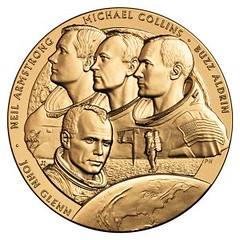
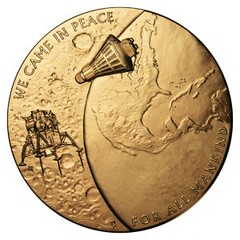
For Iskowitz, every detail must be correct. Artistic license comes in the form of montage, assembling the elements of the composition, but each rendering must be precise and exact. For example, when creating the New Frontier Congressional Gold Medal, which honors Neil Armstrong, Buzz Aldrin, Michael Collins and John Glenn, the artist considered every detail. A portion of the medal’s reverse shows the Friendship 7 capsule orbiting above the earth. To capture this accurately, Iskowitz exhaustively examined images from John Glenn’s mission notes to correctly capture the direction of its orbit and its orientation. The medal received recognition from the International Design Awards.
Iskowitz has said that, while no two projects are the same, designing a coin or medal for the U.S. Mint requires about two months to complete, including the research phase and working through the composition in dozens of variations. He holds the opportunity to design coins and medals in such esteem that they take priority over all other projects. Congressional Gold Medals are the highest civilian honor bestowed on their recipients by the United States of America. Iskowitz designed 11 of them between 2009 and 2016, an accomplishment that has come with recognition within the field.
A final aspect of the design process of any U.S. coin is receiving recommendation from Citizens Coinage Advisory Committee and U.S. Commission of Fine Arts, which Iskowitz often refers to collectively as “erudite national review boards.” Unlike many other artists who view this as an intrusion, Iskowitz seems genuinely to appreciate this vetting and stamp of approval. A coin or medal design must achieve many things: historical accuracy, coinability and aesthetic integrity. The fact that all designs are selected in competition means that the one with the most resonance, the one that carries the most potent message will be selected.
The selections have been prodigious. Iskowitz has designed five reverses for Platinum American Eagles, the issues released in 2006, 2008, 2011, 2013 and 2015. He has designed seven commemorative coins, nine First Spouse coins, six quarters, four Presidential $1 coins, and the list is still growing. Iskowitz also designed the reverse for the 2009 Lincoln, Professional Life cent.
To read the complete article, see:
MONTHLY SUPPLEMENT: JOEL ISKOWITZ AND NARRATIVE ART ON U.S. COINAGE
(http://blog.greysheet.com/monthly-supplement-joel-iskowitz-and-narrative-art-on-u-s-coinage/)
MORE ON THE DELAWARE TERCENTENARY MEDAL
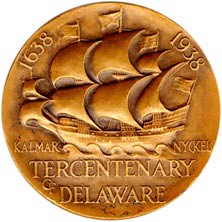
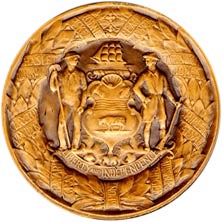
Last week Michael Sanders asked:
I recently bought a Delaware Tercentenary medal dated 1938. The design and antiqued matte finish are identical to Hibler & Kappen #697. However, my example is 70 mm in diameter. The version listed in H&K is 35 mm. "Medallic Art Co. N.V. Bronze" is incused on the rim. There are no designer's initials on the medal that I can find. I'm not the least bit surprised that Medallic Art struck a larger version, but I'm confused by the N.V. designation. The 38 mm version does not carry this (which I assume stands for Nevada).
Jonathan Brecher writes:
The edgemark on HK-697 is MEDALLIC ART CO., N.Y. — with a Y not a V at the end. I expect that Michael's piece is the same, or was intended to be. Since the edgemarks were hand-applied, it would have been very easy to lose a piece of the last letter if the punch was applied at a slight angle.
I've updated the So-Called Dollars web site to capture the edgemark and the mintage figures Dick Johnson suppied, thanks!
Jan Monroe writes:
I think there are a few discrepancies in the number of medals that Dick Johnson reports. I have seen information that indicates that there were actually 125 of the silver medals struck but that only 75 were sold to the public. It really does not matter which information is correct as the medal is quite scarce either way.
With regard to the smaller 37mm medal I believe that only 2,000 were struck. This coincides with data from the final report of the commission/committee. It also is supported by the relatively high prices that this smaller medal achieves in eBay sales. I suspect the difference in the 5,000 vs 2,000 is the original intent versus actual production and sales.
To read the earlier E-Sylum article, see:
DELAWARE TERCENTENARY 1938 (http://www.so-calleddollars.com/Events/Delaware_Tercentenary.html#HK-697)
To read the earlier E-Sylum article, see:
NOTES FROM E-SYLUM READERS: NOVEMBER 26, 2017 : Query: Large Size Delaware Tercentenary Medal
(http://www.coinbooks.org/v20/esylum_v20n49a13.html)

NOTES FROM E-SYLUM READERS: DECEMBER 3, 2017
Three Challenge Coins
Craig Sholley writes:
I saw the snippet about Challenge Coins in The E-Sylum. Here's three of my favorites. The one on the left was presented by MG Huntoon, Commandant of the US Army War College; the one on the right is from the Garrison Commander of the Carlisle Barracks; and the one below (my favorite) was presented by the 366th Air Expeditionary Wing, Air Expeditionary Force, Operation Iraqi Freedom.
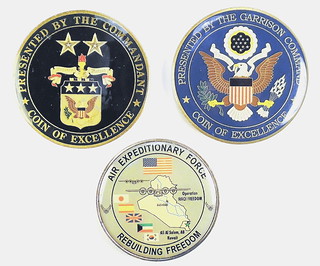
To read the earlier E-Sylum article, see:
MORE COIN MAKER WEB SITES : CHALLENGE COINS (http://www.coinbooks.org/v20/esylum_v20n49a31.html)
More on the NELCO Coin Board Company

Christopher Buck of Lexington, KY writes:
As a long time collector of classic coin boards, I enjoyed seeing the image of the NELCO Lincoln Cent board that David Lange shared. This is a coin board I have never seen before. I did some research and discovered the company was registered on November 10, 1970 to Edwin L. Nelson (president) of 5607 Tomoka Drive, Orlando, Florida. The business was located at One N Orange Avenue, Suite 901, Orlando, Florida.
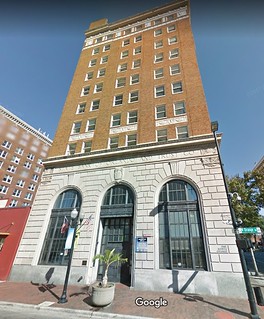 Based on the street view in the attached image, the building was initially constructed for the State Bank of Orlando and Trust Company. Given NELCO was located on the top floor of this
building, it was likely some sort of financial or insurance company which might explain the numismatic angle. Leonard P. Nelson was listed as the vice president so it appears the company was ether a
partnership between brothers or father and son. Either way, NELCO was clearly a shortened version of NELson COmpany as Dave hypothesized. The registration of the company name expired on September 3,
1976 due to non-payment so the company must have closed shop after six years. Anyone with access to Orlando telephone books from this period or the Orlando public library may be able to confirm what
this company did.
Based on the street view in the attached image, the building was initially constructed for the State Bank of Orlando and Trust Company. Given NELCO was located on the top floor of this
building, it was likely some sort of financial or insurance company which might explain the numismatic angle. Leonard P. Nelson was listed as the vice president so it appears the company was ether a
partnership between brothers or father and son. Either way, NELCO was clearly a shortened version of NELson COmpany as Dave hypothesized. The registration of the company name expired on September 3,
1976 due to non-payment so the company must have closed shop after six years. Anyone with access to Orlando telephone books from this period or the Orlando public library may be able to confirm what
this company did.
I also looked into the artist who created the striking portrait of Abraham Lincoln on the back of the NELCO board. Although he signed his name as Bob MacCourt, I considered alternate spellings of his name and found two references under Robert MacCourt and Bob McCourt in the February 18 and February 22, 1968 editions of The Orlando Sentinel respectively. In the two references he is described as a sketch artist who draws portraits with charcoals and lives in Casselberry, Florida just north of Orlando. It appears he had nothing to do with numismatics other than having his artwork printed on the back of the NELCO coin board.
To read the earlier E-Sylum article, see:
COIN BOARDS AND RELATED EPHEMERA (http://www.coinbooks.org/v20/esylum_v20n49a15.html)
225 Years of the United States Mint
Cordially Invites You to a Lecture by ~
David Motl
Acting Deputy Director
United States Mint
entitled
225 Years of the United States Mint
To take place in:
Cash Room of the U.S. Treasury Building
1500 Pennsylvania Avenue, NW (North Entrance)
Wednesday, December 20, 2017 at 12:00 noon
Established in 1792, the United States Mint celebrated its 225th Anniversary in 2017. When the framers of the U.S. Constitution created a new government for their untried Republic, they realized the critical need for a respected monetary system. In April 1792, Congress passed The Coinage Act, which created the Mint and authorized construction of a Mint building in Philadelphia. Since that time, both the United States of America and the U.S. Mint have undergone many changes. This presentation will cover the many ways in which the Mint has grown and changed during its 225-year history
Important Notes: Attendees not possessing valid Treasury Building access pass/identification must obtain advance security clearance through the U.S. Secret Service for entry into the Treasury Building. To obtain clearance, please telephone THA at (202) 298-0550 and supply your full name (with complete middle name), date of birth, social security number, your city and state of residence, and a daytime telephone number. Alternatively, if you have a sufficiently secure email system, you may send this information to THA@treasury.gov. Clearance requests must be made no later than Friday, December 15, 2017.
For more information, see:
http://www.treasuryhistoricalassn.org/
One Big Medal
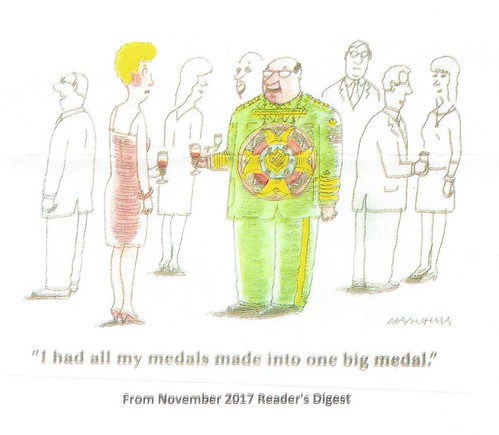
THE 1818 “I OVER 0” REVERSE HALF EAGLE
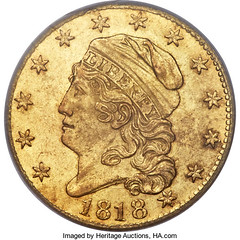
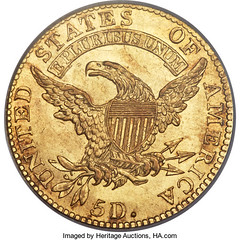
Die varieties of early U.S. Half Eagles have been studied intently by some of the most respected numismatic researchers of all time.
By the early 1880s, John W. Haseltine and John Colvin Randall began systematically classifying early Half Eagles by noting the tiny differences in the punches used to impress the design elements into the dies, and the different placement of the design elements in relation to each other. Their work was refined and expanded in the early 20th century by Edgar Adams, William Woodin and Waldo Newcomer. More recently, scholars like Walter Breen, Harry Bass and John Dannreuther added their findings to the accumulated knowledge of early gold die varieties.
Last March, Heritage Auctions numismatist John W. Sculley joined this distinguished group by correctly identifying the overpunched denomination seen on the reverse of some rare 1818 and 1819 Capped Head Left Half Eagles.
The dramatic overpunched reverse was first used to strike a very scarce variety of the 1818 Half Eagle (called BD-3 in John Dannreuther’s Early U.S. Gold Coin Varieties) and employed again to strike the even more elusive BD-1 variety in 1819. The blundered denomination was actually noticed at an early date, but its true nature was always misunderstood. H.P. Smith and David Proskey were the first numismatists to describe the blundered denomination in print in their description of the coin in lot 904 of their catalog of the Lorin G. Parmelee Collection (New York Coin & Stamp, June 1890):
“1818. Lot 904 Half Eagle: D. in value has been cut over ‘0’: fine sharp impression: minute nicks; very fine.”
The reverse die became known as the famous “5D over 50” reverse in all standard series references and any student of the early Half Eagle series would recognize the nomenclature today, but the real alteration is something quite different.
 In March 2017, when studying the MS63 PCGS 1818 BD-3 Half Eagle in the Hutchinson Collection, John Sculley noticed the obvious misnomer in the “5D over 50” notation – the 5 is obviously not
repunched. Looking closer at the letter superimposed over the “0,” he discovered something much more surprising. The curve of the supposed “D” (for “Dollar”) was much too rounded at the bottom to
have been made with the standard “D” punch used on other Half Eagles of that era. It gradually became clear that the letter used to overpunch the errant “0” was actually an “I.” When carefully placed
so that the serifs of the “I” blended with the curve of the underlying “0,” the missing upright was seamlessly added to create the optical illusion of a “D,” with just a tell-tale crescent of the
original “0” visible to the left of the primary letter. This elegant die-sinking maneuver successfully fooled numismatic scholars for the last 127 years, ever since the variety was first noticed.
Researchers John Dannreuther, Ken Bressett, and die expert Ron Landis confirmed Sculley’s find. Landis noted:
In March 2017, when studying the MS63 PCGS 1818 BD-3 Half Eagle in the Hutchinson Collection, John Sculley noticed the obvious misnomer in the “5D over 50” notation – the 5 is obviously not
repunched. Looking closer at the letter superimposed over the “0,” he discovered something much more surprising. The curve of the supposed “D” (for “Dollar”) was much too rounded at the bottom to
have been made with the standard “D” punch used on other Half Eagles of that era. It gradually became clear that the letter used to overpunch the errant “0” was actually an “I.” When carefully placed
so that the serifs of the “I” blended with the curve of the underlying “0,” the missing upright was seamlessly added to create the optical illusion of a “D,” with just a tell-tale crescent of the
original “0” visible to the left of the primary letter. This elegant die-sinking maneuver successfully fooled numismatic scholars for the last 127 years, ever since the variety was first noticed.
Researchers John Dannreuther, Ken Bressett, and die expert Ron Landis confirmed Sculley’s find. Landis noted:
“My take is that the die-sinker originally used the O punch instead of the D. To correct the mistake, he just used the I punch to add in the stem of the D, instead of trying to make the D punch work – which would most likely have caused some messy doubling. Quite a clever fix that saved them from scrapping the entire die.”
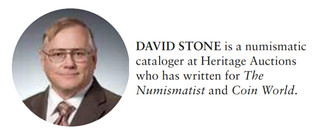 The surprising new information was reported in a front-page article of the March 13, 2017, edition of Coin World, and in the description of the 1818 BD-3 Half Eagle in lot 4250 of
the Hutchinson Collection, Part II (Heritage Auctions, April 2017). This important reverse die should be known as the “I over 0” reverse in all future references.
The surprising new information was reported in a front-page article of the March 13, 2017, edition of Coin World, and in the description of the 1818 BD-3 Half Eagle in lot 4250 of
the Hutchinson Collection, Part II (Heritage Auctions, April 2017). This important reverse die should be known as the “I over 0” reverse in all future references.
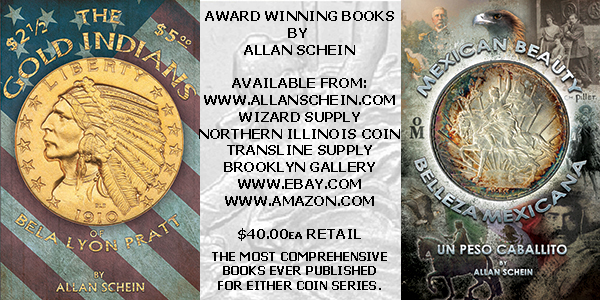
MEDAL-ENGRAVING MACHINES AND ANAGLYPTOGRAPY
Wendell Wolka writes:
I'm searching for the name of the process whereby paper money engravers transferred the image of medallic (three dimensional) portraits to bank note designs. This was accomplished by varying the distance between lines of the engraving in a topographical manner. Counterfeiters had a miserable time trying to copy it and it was quite effective. Any help with a name and a brief description of the process would be appreciated.
Wendell describes the process of anaglyptograpy. I cannot comment on its use in banknote engraving as this is outside my expertize. I can comment, however, on anaglyptography as I have made an extensive study of it.
It is one of the most misunderstood words and process in numismatics. It is NOT a machine that creates engraving for medals, but rather the use of medals for the creation of engravings. Many numismatists had the misconception that it was a machine that replaced the tedious process of hand engraving of dies.
The process was a forerunner (for a brief time, 1838-1861) of photoengraving for making printing plates. Coin and medal books were illustrated by this process, It can be traced back to 1817 by a youthful watchmaker, Christian Gobrecht who later was to become Chief Engraver at the Philadelphia Mint!. The device is similar to a ruling pen. Gonrecht built one to engrave on the back of watch cases.
Later when he was at the Mint he had fellow mint worker Joseph Saxon build one which was used to illustrate several books by Mint Assayers Jacob Eckfeldt and William DuBois. Saxon also built one for a banknote engraver who took it to England and sold it to John Bate.
Bate was a rascal. He claimed he invented the device and got a British patent. The history thereafter is a fascinating story which goes all the way up to British Parliament and involves a fight between French and English publishers with Royal Mint engravers also involved.
I selected the word Anaglyptography for my Vocabulary Word of the week (see elsewhere this issue). The complete entry is too long for an E-Sylum article (2,475 words or 7 pages). I omitted the History. You can find the complete entry including the History on the Newman Portal (see Dictionary, under A for Anaglyptography).
You will enjoy reading the History. Who wins the battle?
To read Dick's complete entry on Anaglyptography, see: https://nnp.wustl.edu/library/dictionarydetail/515360
"Anaglyptography" is an interesting word for an arcane process, but I don't see the word used by bank note engraving researchers who have written about the process. Ormsby's book of 1852, A Description of the Process of Bank Note Engraving discusses the process, calling it medal engraving or medallion engraving, and even pictures a medal copying machine in plate 2, figure 2.
Bowers's book Obsolete Bank Notes calls it a medal-ruling machine. McCabe in Counterfeiting and Technology refers to it as medallion-engraving machine. I have long called it medallion-ruling work. I don't see any of these people using "anaglyptography" as a term for the process. The people most identified with the process are Asa Spencer, Christian Gobrecht, and Joseph Saxton.
Bob McCabe, who devotes almost five pages in Counterfeiting and Technology to the process and the men who made the machines to do it, describes it this way:
Medallion Engraving Machines. Also known as "medal engraving machines" and "image lathes," these devices copied the surface features of coins or medals to produce an engraving that appeared to be three-dimensional. This was done by having a tracing needle move horizontally across the coin or medal in lines that were about 1/200 of an inch apart. The tracing needle was mechanically linked to an engraving point that made a copy of the coin's image on a copper or soft-steel die. To get the three-dimensional effect on the engraved copy, the machine was designed to deflect the tracing needle and the engraving cutter in a vertical direction whenever the needle passed over a raised surface. The amount of deflection was proportional to the actual height of the three-dimensional surface the needle was passing over. On the part of the coin that was flat, there would be no deflection of the tracing needle, and all the lines would be spaced closely together at equal distances, When the tracing needle came across a raised feature, like the side of a nose in a human face, it would be moved vertically. If a feature on a coin stood 1/16 of an inch above the rest of the surface, the engraving point would be moved vertically 1/16 of an inch. This was repeated each time the tracing needle was moved back to a new starting point just 1/200 of an inch above the last trace. At each pass, the needle would be deflected proportionately as it moved across each point of elevation in the image."
He goes on to explain how these different spacings trick the eye. I strongly suggest readers get Bob McCabe's book if they are interested in this process.
From Webster's 1913 Dictionary:
Anaglyptography: The art of copying works in relief, or of engraving as to give the subject an embossed or raised appearance; - used in representing coins, bas-reliefs, etc.
To read the complete entry: http://www.webster-dictionary.org/definition/Anaglyptography
From the The Ephemera Society of America:
Anaglyptography has been defined as “the art of copying works in relief, or of engraving as to give the subject an embossed or raised appearance; — used in representing coins, bas-reliefs, etc.” In point of fact, the process has also been used for portraits, frames, and other dimensional objects.
Anaglyptography is a pantographic process. As a tracing arm moves over an original dimensional item (coin, bas-relief portrait, plaster model of a medal or a frame, even a sculpture), linkage to a graver reproduces the contours of the original as a continuous-line engraving. Vertical differences in the original are translated into horizontal differences (contours) in the engraving. The engraved reproduction plate is similar to a contour map, and when inked gives the strong illusion that the object is embossed. In his 1972 book, Design in Miniature, Watson-Guptill, NY, page 91, David Gentleman shows an original relief cartouche and the anaglyptographic engraving made from it.
To read the complete entry: http://www.sheaff-ephemera.com/list/anaglyptography/
VOCABULARY TERM: ANAGLYPTOGRAPHY
Anaglyptography. A mechanical process of converting a three-dimensional design – an anaglyph – to a line drawing, or an engraved plate. The process, also called medallic engraving, requires a mechanical device similar to a ruling machine. Developed first in the United States in 1817, by Christian Gobrecht, later U.S. Mint engraver, modified somewhat in England in 1829, and independently invented in France in 1830, the process was relatively short lived. It was used, however, for engraving book illustrations and banknotes displaying small RELIEFS as design elements.
A three-dimensional relief item, as a medal, coin, seal, cameo – or its cast replica, pattern or negative – is fastened in the device. A tracing point is repeatedly played over the object’s surface, hundredths of an inch apart, while the design is transferred to either a drawing pen reproducing the design by multiple close-line drawings on paper, or to an etcher inscribing the line on a printing plate.
Anaglyptography – literally embossed writing – was popular 1831-61 but was replaced by the rise of photoengraving following the introduction of that graphic art process in 1880. Modern references to anaglyptography often refer to the technique as MEDAL-ENGRAVING or MEDALLION-ENGRAVING (but both these terms wrongly confuse the general public as a machine that engraves the modulated relief in dies).
Numismatic connection. In 1835 the inventor of the medallic engraver, then a die engraver at the Philadelphia Mint, Christian Gobrecht employed his device to transfer a glyptic design to the surface of a die for engraving a coin design. He did this by making an exact size model of the Liberty Seated device he had chosen to appear on the obverse of this coin.
Gobrecht set up his tracer to reproduce this design on the face of a smooth DIE BLANK properly coated with zinc oxide (CHINESE WHITE). The device drew the exact design on the die’s surface and he was able to create the modulated relief by engraving this design into the die. This is the only reported incidence of this technique in the numismatic field. Though highly attractive, the resulting design was somewhat stiff and mechanical looking.
. . .
Meanwhile in the early 1840s, Saxton returned to Philadelphia to work for the U.S. Mint. In addition to building new scales he built an even more improved anaglyptograph based on the tracing machine Gobrecht had used in 1835 for the Liberty Seated dollar. (Gobrecht was unable to use this for another coin design because he died in 1844).
Saxton’s machine was steam powered and automatic; an operator did not need to reset it constantly. It was used to prepare engravings for two books, published in 1842 and 1846, by the two assayers at the Philadelphia Mint, Jacob B. Eckfeldt (1803-1872) and William E. Du Bois (1810-1881). These were A Manual of Gold and Silver Coins of All Nations and New Varieties of Gold and Silver Coins, Counterfeit Coins, and Bullion.
Also two other Americans had taken an interest in anaglyptographic engravings, both steel banknote engravers, James W. Steel (1799-1879) and Waterman Lilly Ormsby (1809-1883). Both of these gentlemen had built or acquired medallic engraving machines.
Orsmby was a prominent banknote engraver, foe of forgers, founder of the Continental Bank Note Company, and author of a number of books on these subjects. He maintained that the greatest use of anaglyptographic engravings was – not for book illustrations – but for banknote vignettes. He reproduced anaglyptographic samples, described the process, but we are mostly indebted to him for illustrating his anaglyptograph machine in his 1852 book, A Description of the Present System of Bank Note Engraving.
A few books and journals were illustrated with anaglyptographic engravings in the U.S. after the Civil War, but the far larger use by then was banknote vignettes. Nevertheless, the process rapidly fell into disuse in the 1880s with the rise of photoengraving – making printers’ plates from photographic prints – with a continuous tone (as in colotype or heliotype), or a screened process (as in halftone).
Mechanical process. Gobrecht’s first engravings were made from paper impressions of embossed blocks. The original relief object is not used directly because the tracer must constantly ride its surface and possibly damage it. Instead, plaster casts were first employed, even shellacking the plaster to give additional surface strength.
Final solution was to make an ELECTROTYPE of the relief and use this as the actual object to come in contact with the tracer. The electrotype was also advantageous in that it provided the negative from which a positive drawing was obtained.
After the electrotype is fixed in position in the machine, the tracer is setup to cross over its surface. At the end of each path the machine is set to advance only a small distance for the next path. Some engravings exhibit as many as 200 lines per inch, so this setting would be 200th of an inch.
If the surface is completely flat, the etcher makes a straight line. The mechanism is such that when the tracer reaches a rise in relief, it will cause the etcher or drawing pen to deviate from that straight course in proportion to the height of the relief. The adjacent line will make a similar deviation in proportion to its relief. The accumulated effect of all the lines gives a somewhat topographic drawing of the object.
There are some technical aspects of anaglyptographic engravings. Most evident: the accumulated effect of ascending relief will be a closeness of many lines with a darkness to the drawing. The opposite holds true: the effect of descending relief will be widespread lines and a lightness in shading.
Also there is a point of entrance where the first line is drawn; and a point of exit where the last line appears. In most instances the point of entrance would be at 6 o’clock or 9 o’clock on a round object; this would provide horizontal or vertical lines respectively.
For artistic reasons if the operator had a choice he would choose a point of entrance somewhere between 4 and 8 o’clock on the side facing the portrait. This would provide a dark concentration of lines around the facial profile and a light shade areas at the back or top of the head, as if sunlight were falling from above and the face was outlined with a strong shadow.
Retouching. Some retouching was done by adding additional hand-engraved or hand-drawn lines. Most prevalent of these was at the point of exit where an arc was drawn to outline the object, or to add additional shading. A variety of additional shading was effected by adding crosslines, infrequently by solid shading.
Artistic effect. Anaglyptographic engravings had an advantage over freehand drawings in that they were somewhat more accurate to the original contours of the bas-relief object. But in comparison to the photographic process there was no contest and it is certainly understandable the process died with the rise of photoengraving. However, for the brief period it reigned in the mid-19th century it served well its purpose.
At best anaglyptography rendered a relief illustration suitable for printing, but the optical effect on the human eye was one of monotonous gray with a loss of the sharp angular detail so often desirable in small objects like coins and medals. Finally, the requirement for a pattern the tracer wouldn’t damage was a generation away from the original and a further loss of some detail.
Even so it served numismatics in a way no other technique has done: In copying medal designs for printed illustrations, in one instance of aiding a coin die to be engraved, and the engraving
process for banknote vignettes for over half a century!
CLASS 14
REFERENCES:
{1972} Gentleman (David) Design in Miniature. New York: Watson-Guptill. 104 pages, illus.COINS, pp 10-19; ANAGLPYTOGRAPHY, pp 90-93.
{1838} Nolte (Vincent Otto) Memorial of Facts Connected with the History of Medallic Engraving and the Process of M. Collas. London: Charles Tilt. 20 pages. Author Nolte (1779-1856) was the promoter of the 20-volume edition of Tressor de Numismatique et de Glyptique who hired Achille Collas (1795-1858) to publish four anaglpytic plates (and one of text) each week for over 24 years!
{1967} Anaglyptography, Medallion Engraving for Book Illustration; Reprinted with an Original Anaglyptograph from the Art Exemplar [1859] by William John Stannard. 10 pages.
{1975} Frazier (Arthur H.) Joseph Saxton and his Contributions to the Medal Ruling and Photographic Arts. Washington, DC: Smithsonian Institution Press. 17 pages, illus. Brief but excellent.
Looking for the meaning of a numismatic word, or the description of a term? Try the Newman Numismatic Portal's Numismatic Dictionary at: https://nnp.wustl.edu/library/dictionary

ALBERT FORREST MOSIER (1866-1892)
Albert Forrest Mosier (1866-1892), was born the fifth child, the third son of George C. Mosier (1817-1901), a farmer and an immigrant from Hanover, Germany, and Christiana Fehrman Mosier (1834-1915), a native of Canada of a German father and French mother.
His father George eventually sold the 320 acre family farm at Union Township, Porter County, and settled in Valparaiso where he worked in the real estate market. He then moved with his family to Hebron, Porter County, Indiana, where Albert lived with his family at their home. His father became a well to do real estate investor and owner and served as Justice of the Peace in the three townships he lived in. Albert became employed with the Panhandle Railway which served as a food, freight and passenger transport system bringing foodstuffs and goods as well as passengers to and from Hebron.
Little to nothing is known about Albert Forrest Mosier.
 He worked as a railway conductor for the Panhandle Railway, which from 1887-1898, was a predecessor of Atchison, Topeka and Santa Fe Railway subsidiary Panhandle and Santa Fe Railway in
Texas. As a sideline he was an agent for the American Bicycle Company, and sold coins and rubber inking stamps. He is a very similar character to John Gideon Laidacker (1867-1927), another railway
worker who also sold coins, bicycles, antique guns, and other antiques as a sideline.
He worked as a railway conductor for the Panhandle Railway, which from 1887-1898, was a predecessor of Atchison, Topeka and Santa Fe Railway subsidiary Panhandle and Santa Fe Railway in
Texas. As a sideline he was an agent for the American Bicycle Company, and sold coins and rubber inking stamps. He is a very similar character to John Gideon Laidacker (1867-1927), another railway
worker who also sold coins, bicycles, antique guns, and other antiques as a sideline.
In his letter to his sister Rose he tells her he is run out of morphine. He also ran out of another medicine and did not feel inclined to buy more. However, he does tell her he is buying Keeleys Cure. This was a medicine designed by quack doctor Leslie Keeley of the Keeley Institute to cure alcoholism. Apparently Albert F. Mosier was an alcoholic and it took his life at an early age.
He died on September 8, 1892. He is buried in the Hebron Cemetery, Hebron, Porter County, Indiana.
To read the complete article, see:
MOSIER, ALBERT FORREST
(https://sites.google.com/a/numismaticmall.com/www/numismaticmall-com/mosier-albert-forrest)
The entire inventory of the Lupia Numismatic Library is for sale. Individual items will be available before the remaining archives are broken up into parcels sold at philatelic auctions in the U. S. and Hong Kong. Check NumismaticMall.com frequently as dozens of new items with estimates will be posted daily until everything is sold.
All inquiries will be given prompt and courteous attention. Write to: john@numismaticmall.com .
THE BELA LYON PRATT SESQUICENTENNIAL
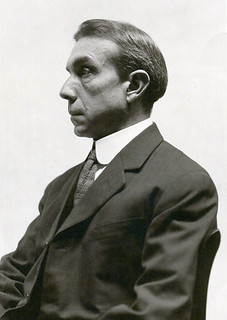 December 11, 2017 is the 150th birth anniversary of Sculptor / designer Bela Lyon Pratt.
December 11, 2017 is the 150th birth anniversary of Sculptor / designer Bela Lyon Pratt.
Born in Norwich, Connecticut in 1847, in numismatic circles Pratt is best known for his design of the quarter and half eagle Indian head coins of 1908 to 1929. The Slater Memorial Museum in Norwich presented a retrospective of Pratt's work with an opening of the exhibit October 15th, and will continue through early January 2018. Occupying three separate exhibit rooms with works by Pratt, and some by other family members including Great Granddaughter Amy Laugesen. The exhibit borrowed works from private collectors, family members and other sources to stage the most extensive retrospective of his work since his memorial exhibition held in 1918 at the Museum of Fine Art, Boston. Pratt was the inaugural sculpting professor at the School of the MFA from 1893 until his death on May 18th, 1917.
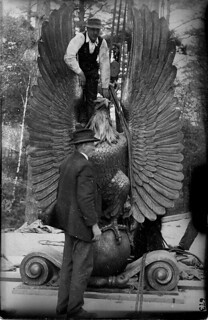 The Big Eagle was a magnificent piece set on top of the Abington Arch, a Civil War Memorial at the eleven acre Island Grove Park, in Plymouth County, Massachusetts. Pratt’s Eagle stands
11' 4" tall with a wingspan of 6' 8". This photo shows Pratt standing on top of the sculpture during its installation in 1912.
The Big Eagle was a magnificent piece set on top of the Abington Arch, a Civil War Memorial at the eleven acre Island Grove Park, in Plymouth County, Massachusetts. Pratt’s Eagle stands
11' 4" tall with a wingspan of 6' 8". This photo shows Pratt standing on top of the sculpture during its installation in 1912.
LEFT: The Abington Eagle, a/k/a The Big Eagle, 1912, Bela Lyon Pratt. Photo courtesy of The Historical Society of Old Abington, Inc.

 RIGHT: The Whaleman, 1912, Bronze, Bela Lyon Pratt, for New Bedford, MA. Photo courtesy of the Pratt Family archives.
RIGHT: The Whaleman, 1912, Bronze, Bela Lyon Pratt, for New Bedford, MA. Photo courtesy of the Pratt Family archives.
For more information on the Slater Memorial Museum, see:
http://www.slatermuseum.org/

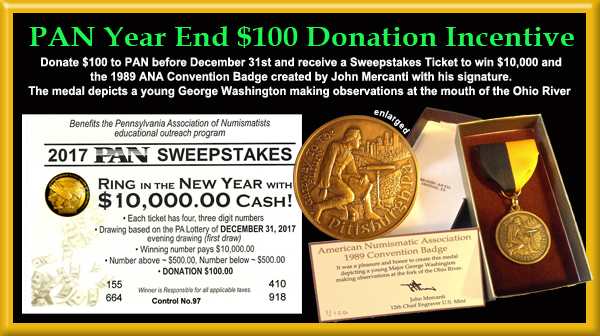
BOB LEONARD'S NUMISMATIC MEDITERRANEAN CRUISE
Like Numismatourist (TM) Dr. Howard M. Berlin, I like to see coin exhibits when traveling. On a Mediterranean cruise with Viking last month, I visited museums in Naples, Heraklion, Jerusalem, Jaffa, Nicosia, Rhodes, Delos, and Delphi, but regrettably missed meeting the curator of the Vatican Numismatic Cabinet (Medagliere) because of a bad flight connection.
Museo Archaeologico Nazionale di Napoli
The Museo Archaeologico Nazionale di Napoli has a coins and medals exhibit on the first floor, but it was closed at the time of my visit. However, I bought a copy of their guide, la collezione
numismatica per una storia monetaris del mezzogiorno, in the museum shop. This is a 134-p. soft cover book, with some color illustrations, giving the history of Italian money from the ancient
Greeks to the Kingdom of Naples, with chapters written by experts in each area (Italian).
Heraklion Archaeological Museum
The Heraklion Archaeological Museum has some possible precoinage money, Cypriot copper oxhide ingots, but of course no coins because it houses the material recovered from Knossos.
Israel Antiquities Authority
In Jerusalem I kept an appointment with old friend Dr. Donald Ariel, Head, Coin Department, National Treasures, Israel Antiquities Authority. They moved a few years ago from the Rockefeller Museum
(near the Damascus Gate), and he showed me their new temperature- and humidity-controlled walk-in safe. They keep all the coins excavated by permit in Israel, about 265,000 at present. The coins are
stored in trays (old collection, plus some recent finds) or in paper envelopes in plastic boxes, except for a couple of massive unseparated hoards of copper coins. I asked Donald if they have had any
problems with corrosion with this system, and he said generally not, showing me about eight "bad" coins that required further treatment; apparently the low humidity is the key.
This is NOT an exhibit, and I was given permission because I wanted to see some coins referenced in a paper I had just submitted for a publication coordinated by the IAA. (Donald also mentioned that a paper I published in 1997 is going to be cited in another paper in 2017, very gratifying.)
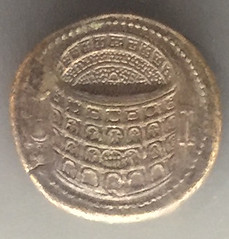
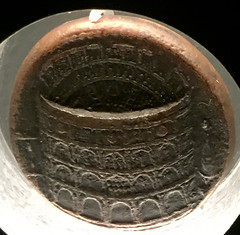
The IAA offices are on the campus of the Israel Museum, which is a must for anyone visiting Jerusalem, though off the beaten path. At the time of my visit they had a temporary exhibit of 75 Roman gold coins from the Victor Adda Collection, beautifully displayed in a rotunda. These don't photograph well, but the museum provided two leaflets, Faces of Power and Coins in the Exhibition, identifying every coin and putting them in context. The Israel Museum also includes many choice examples of ancient Jewish coins, as you would expect, but also TWO superb examples of the Colosseum sestertius of Titus, in different rooms.
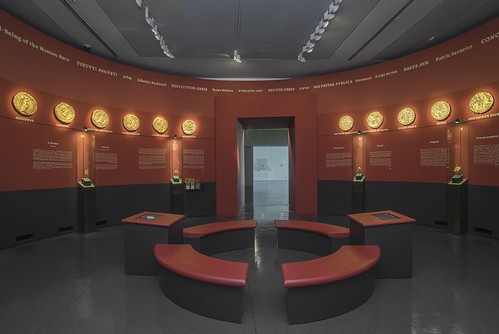
Old Jaffa Museum of Antiquities
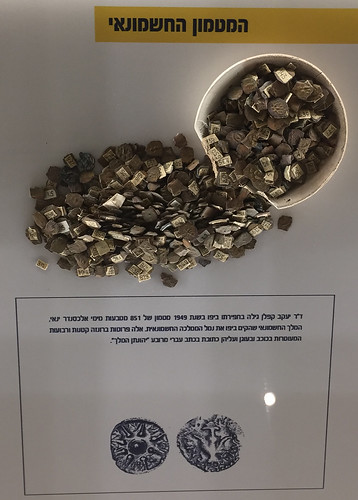 In Jaffa I visited the Old Jaffa Museum of Antiquities, which houses finds collected by municipal archaeologist Dr. Jacob Kaplan. Among many artifacts, it has a case of coins from ancient
times to the Crusades, including a hoard of 851 Hasmonean leptons of Alexander Jannaeus--each with a number affixed to the back!
In Jaffa I visited the Old Jaffa Museum of Antiquities, which houses finds collected by municipal archaeologist Dr. Jacob Kaplan. Among many artifacts, it has a case of coins from ancient
times to the Crusades, including a hoard of 851 Hasmonean leptons of Alexander Jannaeus--each with a number affixed to the back!
Cyprus Museum
The Cyprus Museum in Nicosia (Lefkosia) houses many outstanding antiquities, including a fine display of the coins of the ancient Cypriot kingdoms, shown above a mirror so that the reverses can be
seen, and with pictures of coins to fill in those missing from the collection. These are too small to photograph well, but the museum also houses finds from the Polish excavations at Paphos,
1965-2015.
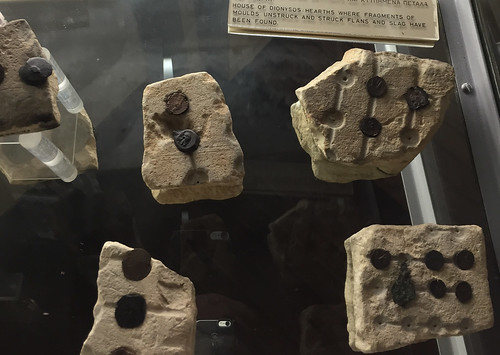
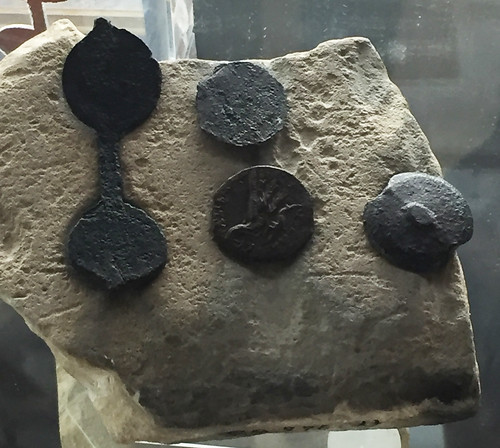
Among objects recovered were open limestone molds and planchets from the Ptolemaic mint at Paphos. These bronze coins were struck on cast planchets, like ancient Jewish bronze coins; a hole was drilled to center a compass, then the circular mold scraped out around that and sprues and runners cut in. A number of these molds are shown in the exhibit; in some of the openings planchets have been inserted, showing either the boss from the centration hole or the smooth upper side, while in others struck coins have been inserted for exhibit purposes. Coins from the Roman period are also displayed.
Leventis Municipal Museum
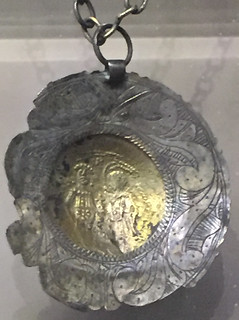 Nicosia has another excellent museum, the private Leventis Municipal Museum of Nicosia. Its coin exhibits pick up where the Cyprus Museum leaves off, covering the Byzantine and Frankish
periods. One that I found particularly interesting was a gold hyperpyron of Isaac II Angelus, 1185-1195, made into a jewel.
Nicosia has another excellent museum, the private Leventis Municipal Museum of Nicosia. Its coin exhibits pick up where the Cyprus Museum leaves off, covering the Byzantine and Frankish
periods. One that I found particularly interesting was a gold hyperpyron of Isaac II Angelus, 1185-1195, made into a jewel.
While the museums in Rhodes (Archaeological Museum), Delos, and Delphi hold many wonderful things, there is nothing numismatic in them.
My advice: plan ahead when traveling, and let the local guides know that you are interested in coins.
To read the earlier E-Sylum articles on the Victor Adda Collection, see:
EXHIBIT: THE VICTOR ADDA COLLECTION (http://www.coinbooks.org/v20/esylum_v20n26a21.html)
MORE ON THE VICTOR ADDA COLLECTION (http://www.coinbooks.org/v20/esylum_v20n29a24.html)
COINAGE PRESSES AND THE ENGINEER’S THUMB
Towards the end of The Engineer’s Thumb, we learn that the hydraulic press that Victor Hatherley is hired to inspect and suggest a course of repair is actually being used to strike counterfeit coins. I have always been troubled by the below passage that Arthur Conan Doyle wrote for the story:
 ‘”We are now,” said he, “actually within the hydraulic press, and it would be a particularly unpleasant thing for us if anyone were to turn it on. The ceiling of this small chamber is
really the end of the descending piston, and it comes down with the force of many tons upon this metal floor. There are small lateral columns of water outside which receive the force, and which
transmit and multiply it in the manner which is familiar to you. The machine goes readily enough, but there is some stiffness in the working of it and it has lost a little of its force. Perhaps you
will have the goodness to look it over, and to show us how we can set it right.”
‘”We are now,” said he, “actually within the hydraulic press, and it would be a particularly unpleasant thing for us if anyone were to turn it on. The ceiling of this small chamber is
really the end of the descending piston, and it comes down with the force of many tons upon this metal floor. There are small lateral columns of water outside which receive the force, and which
transmit and multiply it in the manner which is familiar to you. The machine goes readily enough, but there is some stiffness in the working of it and it has lost a little of its force. Perhaps you
will have the goodness to look it over, and to show us how we can set it right.”
‘I took the lamp from him, and I examined the machine very thoroughly. It was indeed a gigantic one, and capable of exercising enormous pressure. When I passed outside, however, and pressed down the levers which controlled it, I knew at once by the whishing sound that there was a slight leakage, which allowed a regurgitation of water through one of the side cylinders. An examination showed that one of the india-rubber bands which was round the head of a driving- rod had shrunk so as not quite to fill the socket along which it worked. This was clearly the cause of the loss of power, and I pointed it out to my companions, who followed my remarks very carefully, and asked several practical questions as to how they should proceed to set it right. When I had made it clear to them, I returned to the main chamber of the machine, and took a good look at it to satisfy my own curiosity. It was obvious at a glance that the story of the fuller’s earth was the merest fabrication, for it would be absurd to suppose that so powerful an engine could be designed for so inadequate a purpose. The walls were of wood, but the floor consisted of a large iron trough, and when I came to examine it I could see a crust of metallic deposit all over it. I had stooped and was scraping at this to see exactly what it was, when I heard a muttered exclamation in German, and saw the cadaverous face of the Colonel looking down at me.
This seems outrageously large to me. According to the chronologists, this story takes place in 1889. Now take a look at this video of a steam powered coinage press from the Carson City mint that was functioning from 1870 – 1885 and again from 1889 until 1893.
It seems unreasonable that there would be a area large enough to fit three grown men under a piston that could crush them as the story suggests.
Do we have any engineers in our reading audience that could shed some light on this matter?
To read the complete article, see:
Coinage Presses and The Engineer’s Thumb
(http://fourthgarrideb.com/2017/11/23/coinage-presses-and-the-engineers-thumb/)

ALEX SHAGIN’S SHERLOCK HOLMES MEDALS
1990 Sherlock Holmes Medal
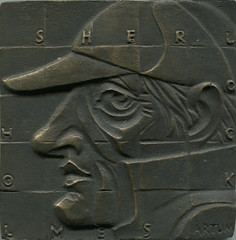
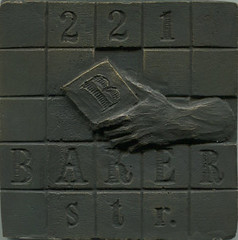
From the George S. Cuhaj (the 14th Garrideb, aka Cardinal Tosca) Collection
Alex Shagin, a former head engraver with the Leningrad Mint, was commissioned in 1990 to sculpt a medal featuring Sherlock Holmes. Cast in both silver and bronze, it was limited to 100 castings. We do not know if this 100 limit was per metal or for the overall series.
The silver medal was initially offered at $175, but would later be reduced to $150. The bronze medal sold for $75.
OBVERSE: SHERLOCK / (left facing profile of Sherlock Holmes, wearing a deerstalker cap) / HOLMES
REVERSE: 221 / B (held by a left hand) / BAKER / Str.
75 mm, Bronze, Square
and
75 mm, Silver, Square
To read the complete article, see:
Alex Shagin’s 1990 Portrait Medal of Sherlock Holmes
(http://fourthgarrideb.com/2017/11/22/alex-shagins-1990-portrait-medal-of-sherlock-holmes/)
1991 Arthur Conan Doyle Medal
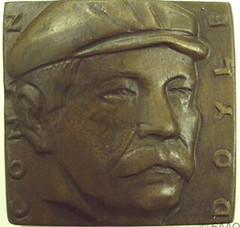
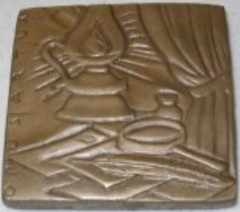
In 1991, Alex Shagin, a former head engraver with the Leningrad Mint, cast a medal featuring Arthur Conan Doyle, which was marketed by Sherlock, Stock & Barrel, a firm owned by Edward C. Rochette, the 4th Garrideb of our scion. Cast in both silver and bronze, they were limited to 100 castings. We do not know if this was one hundred in each metal or total for both metals. The bronze medal sold for $75 and the silver for $150.
OBVERSE: CONAN / (three-quarter bust of Arthur Conan Doyle, facing right, wearing a cap) / DOYLE
REVERSE: OPUS ARTUM / (letters & papers on a desk, along with a inkwell and quill, magnifying glass, and a lit oil lamp in front of a window with curtains)
75 mm, Square, Bronze
and
75 mm, Square, Silver
To read the complete article, see:
Alex Shagin’s 1991 Portrait Medal of Arthur Conan Doyle
(http://fourthgarrideb.com/2017/11/22/alex-shagins-1991-portrait-medal-of-arthur-conan-doyle/)
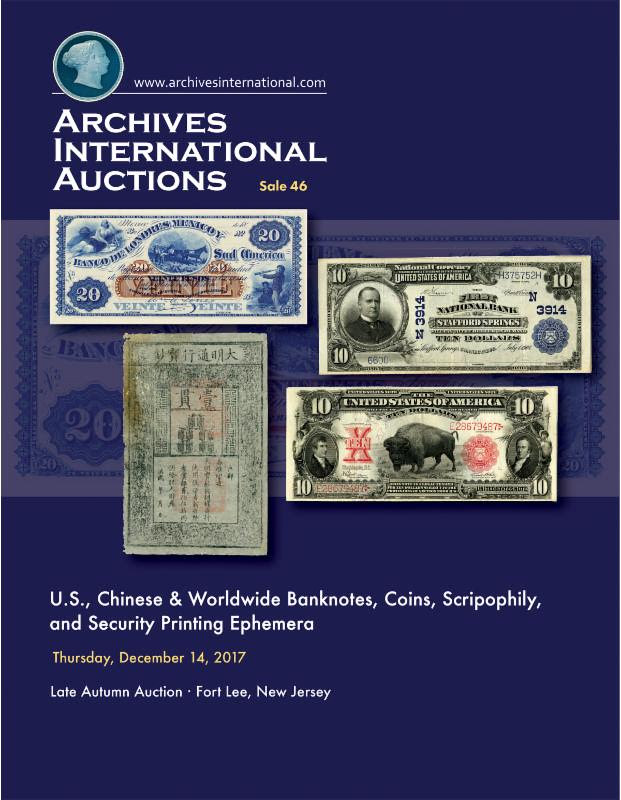
WSJ HIGHLIGHTS MINT'S PROOF COIN MARKUP
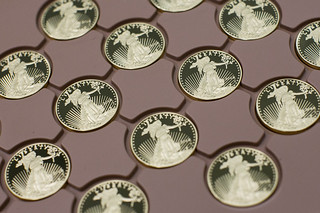 The U.S. Mint makes a pretty penny selling gold and silver coins. But there are two sides to the deal, which some investors are calling highway robbery.
The U.S. Mint makes a pretty penny selling gold and silver coins. But there are two sides to the deal, which some investors are calling highway robbery.
After years of making pennies and nickels that cost more to produce than they are worth, the Treasury Department is making a mint off a line of pricey American Eagle coins in what is known as proof condition—sheathed in plastic and never touched by human hands. Last year, sales totaled $112 million.
The government currently is selling the gold-coin proofs at a 25% markup over per-ounce gold prices, a premium that can run as high as $360 per coin. The silver coins carry a more than 200% premium over market silver prices.
That might be well worth it for coin collectors and hoarders—or for stashing in a post-apocalypse bunker along with the guns and freeze-dried macaroni. But some unhappy investors have deposited them into retirement accounts, where the shiny gold and silver coins have performed like lead sinkers.
Marvin E. Johnson, 61, of Kanawha, Iowa, said American Bullion Inc. sold him 930 American Eagle silver proof coins for his retirement account. He paid the equivalent of nearly 2 1/2 times the market price of silver. Then he sued when he saw his investment drop like a rock.
“He bought them at a premium where I don’t think he’d ever make a profit,” said Thomas Reavely, Mr. Johnson’s lawyer and coin collector.
Mr. Johnson and American Bullion later settled the coin dispute confidentially. Orkan Ozkan, American Bullion’s chief executive, said it wasn’t the company’s fault. Mr. Johnson, he said, paid the going rate: “We buy it high, mark it up and sell it high.”
Then he pointed a finger at the government. “Maybe you should ask that question of the Mint: Why are you charging so much for these coins?” he said.
The U.S. Mint does operate a bit like a coin dealer. Salespeople answer phones. An online store, with a pop-up chat window, adorns the website. Customers can sign up to have annual proof sets charged to their credit cards.
Mint profits on gold Eagle proofs hit nearly 18% last year. Net profits on the Silver Eagle proofs were even better, reaching about 41% last year.
The Mint transfers its profits to the Treasury’s General Fund. “We are not in it to make money,” said Kristie McNally, the Mint’s chief financial officer.
Mint officials said they pitch proof coinage as collector’s items, not investments. But Congress kept the door open to putting the coins into retirement account investments a few years after banning other collectible items in 1981.
Lawmakers allowed American Eagle proofs as an exception to the rule, making them a favorite for coin dealers pitching a “Gold IRA” to retirees.
The American Eagle proof, a double-struck coin, has been described as the most beautiful coin ever made. Plus, “you get a certificate” and “a little leather box,” said Rick Boss of Ohio, a proof-coin collector and retired AT&T engineer. “You’re getting a piece of history.”
Nonetheless, Jeffrey Christian, a precious-metals investment adviser, said he steers his clients away: “It’s sort of like buying a car and driving it off the parking lot. It will have an immediate depreciation.”
Even the WSJ can get its numismatic facts wrong. NOTE: when talking to reporters, spell out the word D-I-E. -Editor
Gold and silver proof coins sold by the U.S. Mint aren’t colored with a special dye. An earlier version of this article incorrectly stated a special dye was used.
To read the complete article, see:
U.S. Mint’s Gold and Silver Coins Turn to Lead for Some Retirement
Investors (https://www.wsj.com/articles/u-s-mints-gold-and-silver-coins-turn-to-lead-for-some-retirement-investors-1511720285)
1913 LIBERTY NICKEL HOLDER BRINGS $10,800
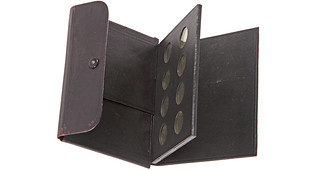
Heritage’s Nov. 1 and 3 sessions featuring Part IX of the Eric P. Newman collection had some wonderful coins that had been off the market for at least a generation and totaled $4.5 million.
One lot showed the robust interest in a more esoteric corner of the marketplace. An eight-slot leather coin holder, made around 1920, that once held all five of the 1913 Liberty Head 5-cent coins, brought $10,800 at Newman IX. The set was purchased intact from the “Col.” E.H.R. Green estate — with the famed “nickels” in place — by a partnership of Eric P. Newman and B.G. Johnson. The five 1913 Liberty 5-cent coins have long since dispersed, including the most famous example: the George O. Walton example graded Proof 63 by Professional Coin Grading Service, which was long thought to be lost after allegedly disappearing in a 1962 car crash. That example emerged four decades later and would sell at Heritage’s 2013 Central States Numismatic Society auction for $3,172,500.
To read the complete article, see:
Why did this old leather coin holder sell for $10,800?
(https://www.coinworld.com/news/us-coins/2017/11/why-leather-coin-holder-sold-for-over-ten-thousand.html)
To read the earlier E-Sylum article, see:
NOTES FROM E-SYLUM READERS: NOVEMBER 26, 2017 : PCGS Type 1.0 Holder Sold (http://www.coinbooks.org/v20/esylum_v20n49a13.html)
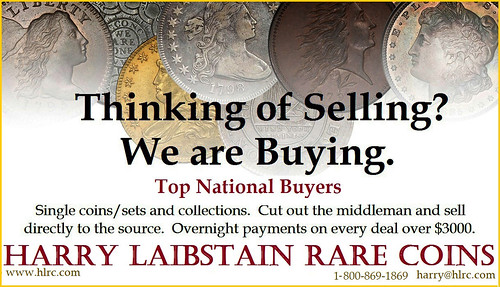
ROMAN SERRATED DENARII
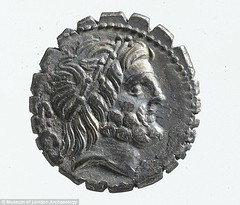
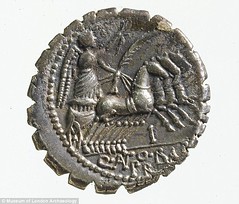
Bob Leonard writes:
I wouldn't challenge Dick Johnson on a minting term, but this is certainly not an example of Hot Shortness; it's a serrate denarius of the Roman Republic, with the edges deliberately notched prior to striking. And it is of virtually pure silver, with negligible lead content.
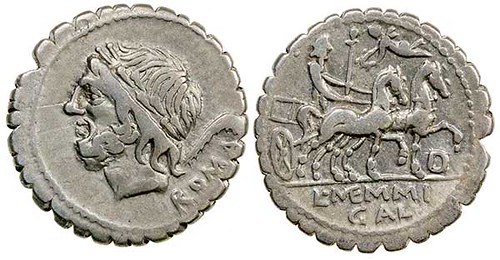
This Roman Republican denarius was issued by L. Memmius Galeria in about 106 BC. The obverse depicts the right facing head of Saturn with ROMA behind. The reverse depicts Cupid flying over a biga driven right by Saturn, with "L. MEMMI GAL" in two lines below. The edge of this coin is serrated.
Serrated denarii are unique to the Roman Republic with most issued from the late 2nd to early 1st century BC. While relatively common, after more than 200 years numismatists have not agreed on why some types of Republican denarii are serrated others are not, even if issued simultaneously. We do not see any types with both serrated and non-serrated examples. While a rare example could exist as a mint error, I have never encountered one. Each type is either serrated or not.
I have looked at many examples and I can make the following observations.

The depth and spacing of the serrations are inconsistent as are their positions when two example of the same type are compared. This shows each serration was individually cut, probably with a hammer and chisel.
There are metal ridges inside of many of the cuts, parallel to the coin's surface, even on mint state examples. A chisel cut to the edge of a coin would raise ridges perpendicular to the surface, yet these have been pushed flat parallel to the surface inside the cuts. This is consistent with the ridges being raised prior to striking and pushed flat on striking. Had they been post striking they would still be perpendicular to the edge, and highly worn in circulation. Thus the serrations are part of the original minting process.
With 33 individual serrations, not unusual for one of these, it would have been very labor intensive to serrate the several hundred thousand coins of each type that would have been issued (possibly a million for some issues). It seems unlikely this would be done without a specific need to do so. I know of two competing theories for that need.
The first is an anti-counterfeiting measure making the minting of counterfeit fourrée (silver wrapped base metal core) denarii difficult. Wrapping silver foil around an already serrated copper core would cover the serrations so that they would not show. Cutting serrations in a copper core already wrapped in silver would expose the copper core defeating the purpose. Thus serrating denarii would be an effective anti-counterfeiting method at a time many fouree denarii were appearing, although a few serrated fourrée are known, they are very rare. The problem with this theory is large numbers of non-serrated denarii were issued simultaneously with serrated ones and there are long periods during which only non-serrated denarii were issued. If it were to stop counterfeiting why were most denarii issued without serrations.
The second theory is serrations pre-exposed the solid silver making such coins more readily acceptable to as payment to non-Roman people less used to Roman denarii who might there wise have wanted to test cut every coin before accepting a large payment of many denarii. I believe the time line of their issue suggests this is the correct theory.
To read the complete article, see:
Roman Serrated Denarii (http://www.calgarycoin.com/reference/articles/serrated/serrated.htm)
Some examples from the ANS's Coins of the Roman Empire Online:
RRC 313/1b (http://numismatics.org/crro/id/rrc-313.1b)
To read the earlier E-SYlum articles, see:
VOCABULARY TERM: HOT SHORTNESS (http://www.coinbooks.org/v20/esylum_v20n46a15.html)
NOTES FROM E-SYLUM READERS: NOVEMBER 19, 2017 : More on "Hot Shortness"
(http://www.coinbooks.org/v20/esylum_v20n48a11.html)
THE 1868 CYRUS FIELD CONGRESSIONAL GOLD MEDAL
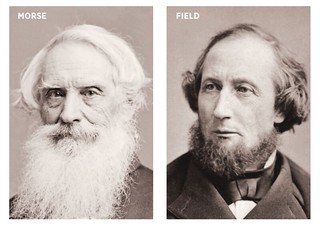 This month, I want to touch on a largely forgotten piece of history that was a precursor to our current Information Age. A few years ago, while I was working on the Edward C. Rochette Money
Museum collection, I came across a very interesting large medal related to the early years of telegraphic communication. I was especially intrigued by its unusual size (103mm) and aluminum
composition. What caught my attention, however, was the piece’s early date—1868. At that time, aluminum was a very expensive novelty medal, worth even more than gold!
This month, I want to touch on a largely forgotten piece of history that was a precursor to our current Information Age. A few years ago, while I was working on the Edward C. Rochette Money
Museum collection, I came across a very interesting large medal related to the early years of telegraphic communication. I was especially intrigued by its unusual size (103mm) and aluminum
composition. What caught my attention, however, was the piece’s early date—1868. At that time, aluminum was a very expensive novelty medal, worth even more than gold!
More recently, as I was researching the use of Morse code (a set of audible signals that represent the letters in the alphabet) for the ANA’s World War I exhibit, I remembered this medal for its connection to the early telegraph. The piece in question is the Congressional Medal honoring the achievements of Cyrus W. Field and was struck by the U.S. Mint to commemorate the laying of the first permanent transatlantic cable for telegraphic communication.
Samuel F.B. Morse, an artist turned-inventor, conceived the idea for the electric telegraph in 1832, around the same time that several European inventors proposed a similar concept. Morse, working independently, built a functioning telegraph in the mid- 1830s, followed in the late 1830s by his invention of Morse code. Morse opened the world’s first commercial telegraph line with the message “What hath God wrought,” sent in Morse code from the U.S. Capitol to a railroad station in Baltimore in 1844. Within a decade, more than 20,000 miles of telegraph cable crisscrossed the country.
Mostly unknown today, Cyrus West Field (1819-92) was an American entrepreneur who made a fortune as a businessman and financier. In 1854 he focused his energy on his new passion: connecting America and Europe by telegraph.
Field secured a charter to lay an insulated telegraph line across the Atlantic Ocean and joined several investors and engineers, including Samuel Morse, to begin work on the project. Known as the “Cable Cabinet,” the group was responsible for connecting St. John’s, Newfoundland, with Nova Scotia. With this experience under his belt, Field went on to form the American Telegraph Company in 1855, which soon became one of the world’s largest telegraph agencies, second only to Western Union.
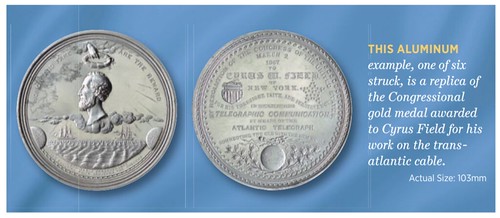
In 1857 the Atlantic Telegraph Company, with backing from the United States and Great Britain, began laying the first transatlantic cable. On August 16, U.S. President James Buchanan and Great Britain’s Queen Victoria exchanged messages, officially initiating nearly instantaneous communication across the Atlantic. Unfortunately, the cable was not strong enough to withstand the strain, and the current it carried was too weak for clear and consistent transmission. By the beginning of September, it had failed completely.
Field made three more unsuccessful attempts over the next few years. On his fifth try, this time with the AngloAmerican Telegraph Company and more durable equipment, he finally succeeded in laying the first permanent cable across the Atlantic Ocean in 1866. The 1,852 miles of cable were laid using the largest sailing steamship of the time, the S.S. Great Eastern.
Field became an instant worldwide celebrity and received honors and recognition from many nations and scientific societies—and he made a massive profit. In 1867 he was awarded a Congressional gold medal and the grand prize at the International Exposition in Paris for his work. Field later promoted other oceanic cables, including telegraph lines that stretched from Hawaii to Asia and Australia. Subsequently, he became involved in several successful business ventures and western railroads, but ultimately his luck ran out, and he went bankrupt in 1887. Field died on July 2, 1892, in New York City.
The medal itself has a history nearly as interesting as its subject. Issued in gold (2 pieces), aluminum (6 known) and bronze (128), the 103mm medal was designed by Joseph Goldsborough Bruff, supervising architect of the Treasury Department. William Barber, an assistant engraver at the time, was tasked with executing the piece, which he completed in early 1868. The mint later produced 76mm restrikes in the 20th century.
The obverse depicts a bust of Cyrus W. Field facing left with a hand coming down from the heavens and placing a laurel crown on his head. Below him are ships laying the transatlantic cable from one hemisphere, marked AMERICA, to the other, EUROPE. The inscription reads, HONOR AND FAME ARE THE REWARD/INDOMITABLE PERSEVERANCE/AND ENDURING FAITH ACHIEVED THE SUCCESS.
On the reverse, oak and laurel branches surround a globe surmounted by lightning that zigzags behind a torch placed over a caduceus. An American shield is on the left, and a star composed of smaller stars is to the right of the legend, which reads BY THE RESOLUTION OF THE CONGRESS OF THE UNITED STATES, /MARCH 2,/1867./TO/CYRUS W. FIELD /OF/NEW YORK/FOR HIS FORESIGHT, FAITH, AND PERSISTENCY,/IN ESTABLISHING/TELEGRAPHIC COMMUNICATION,/BY MEANS OF THE/ ATLANTIC TELEGRAPH,/CONNECTING THE OLD WITH THE NEW WORLD.
For more information on the American Numismatic Association, see:
https://www.money.org/
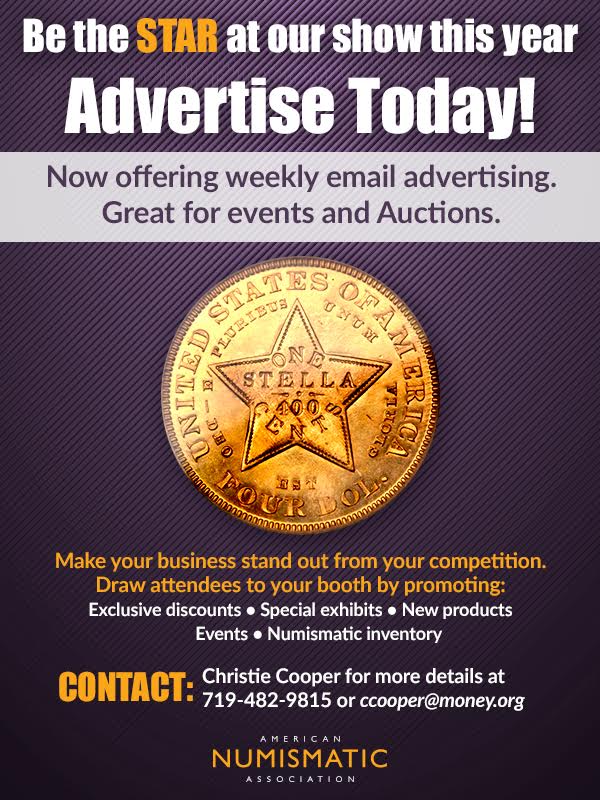
SWAZILAND COINS STAND IN FOR POUNDS
A coin collector who swindled TfL after he realised Swaziland currency could be used to top up his Oyster card has been spared jail.
David Drukarz, 64, used the African Iilangeni, which are roughly the same size and weight as £1 coins but worth just over 5p.
It is believed he used the top-up trick on 54 different occasions between November 2016 and January this year.
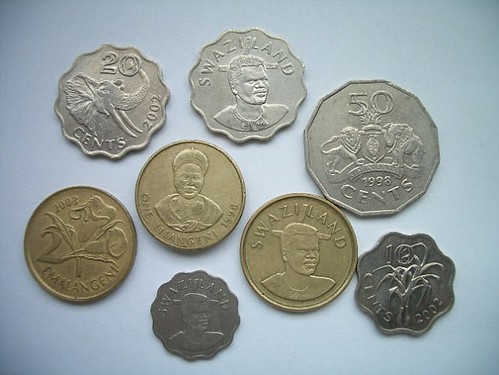
He used the African Iilangeni (second from left, middle) which are roughly the same size and weight as £1 coins but worth just over 5p
After topping up the card he would withdraw the money from the ticket office.
He was caught in February when a plain clothes police officer saw him at a ticket machine at Wembley Park station with two Oyster cards.
Police then searched his home and discovered 508 Swaziland coins, three bags of Israeli shekels and 22 Oyster cards hidden in the inside of his oven.
To read the complete article, see:
Coin collector who swindled TfL by using currency from SWAZILAND to top up his Oyster card
54 times is spared jail (http://www.dailymail.co.uk/news/article-5121051/Coin-collector-used-SWAZILAND-currency-Oyster.html)
BANKNOTE OF THE YEAR NOMINEES
It may be the root of all evil, but money has an artistic side, too. From Fiji’s celebratory seven dollar note to Switzerland’s 50 franc note to Australia’s Possum Magic coin collection, we look at the most attractive legal tender
Australia’s new Possum Magic coin set bucks convention. Playing on a picture book by fantasy author Mem Fox, the set’s two-dollar coins feature colours including turquoise, gold and orange.
The vibrant tones underline currency’s talent to be more than just cold cash but a platform for creative design. In particular, banknotes make natural canvases.

Just look at Hong Kong’s red, iridescent HK$100 note and its fiery orange HK$1,000 counterpart, Their engraved lions – the HSBC emblems Stephen and Stitt – ooze presence mirrored by their lucky stone cousins that proudly guard the Hong Kong head office and London’s Canary Wharf. “When HSBC’s new global headquarters were opened in Canary Wharf, London, it was only fitting that Stephen and Stitt were included in the design too,” the bank states, adding that eight lucky coins are buried in the base as tradition dictates.
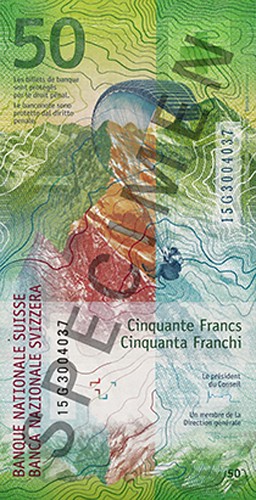 Switzerland’s 50 franc note is the current bank note of the year title holder. “The bright green vertical banknote depicts dandelion seeds, a paraglider aloft in the mountains and a
strikingly playful human hand”, says the International Bank Note Society.
Switzerland’s 50 franc note is the current bank note of the year title holder. “The bright green vertical banknote depicts dandelion seeds, a paraglider aloft in the mountains and a
strikingly playful human hand”, says the International Bank Note Society.
Candidates for the 2017 prize include India’s 200 rupee note, Australia’s A$10 note, Switzerland’s 20 franc note, Canada’s C$10 note, and Mexico’s 100 peso note.
To read the complete article, see:
How banknotes and coins make canvases for designs: artistic licence to
print pretty money (http://www.scmp.com/culture/arts-entertainment/article/2121710/how-banknotes-and-coins-make-canvases-designs-artistic)
THE TWO DOLLAR BILL BOOK
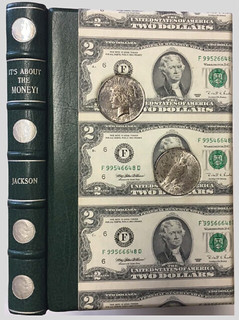 Kater-Crafts Bookbinders is a family owned business started in 1948 by Mel Kavin and run today by his three children. 2018 will be our 70th year of operation.
Kater-Crafts Bookbinders is a family owned business started in 1948 by Mel Kavin and run today by his three children. 2018 will be our 70th year of operation.
This $2 Bill book is one of a random series of books that our father Mel and his friend Vick Knight, produced over the years with the cover material relating to the book's contents. The first
one, "Origin of the Species", was bound in the 1960's. The cover was Monkey fur with the figure of a man in tooled leather. Far from correct these days!
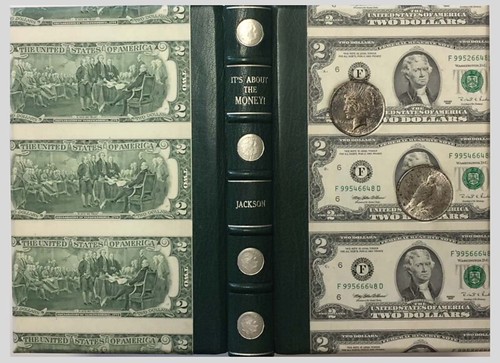
Other entries include:
"I Married Adventure" bound in Zebra printed Cowhide
"Hawaii" bound in Tappa bark cloth
"The Jungle Book" bound in Cobra skin
"The Wind in the Willows" bound in Bullfrog skin
"Leaves of Grass" bound in AstroTurf
"Fahrenheit 451" bound in Asbestos (A presentation to Ray Bradbury)
"The Seven Pillars of Wisdom" bound in Camel skin
"The Tournament of Roses" bound in football leather
"The Stingray Shuffle" bound in Stingray skin
"A Field Guide to Western Reptiles" bound in Rattlesnake skin
"Moby Dick" bound in Whale skin (A presentation to Charlton Heston)
To visit the firm's web site, see:
http://www.katercrafts.com/
To read the Atlas Obscura article, see:
Kater-Crafts Bookbinders (https://www.atlasobscura.com/places/katercrafts-bookbinders)

NEW BOOK: THE MEDIEVAL GIRDLE BOOK
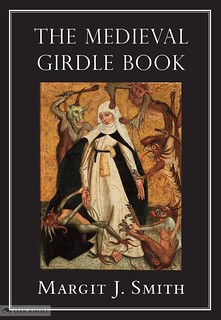 Between the 14th and 16th centuries a little-known book format, now called the girdle book, was used throughout various European countries. The girdle book is distinguished by a cover that
extends beyond the limits of the book itself and may end in a knot, hook or ring, or may be left ungathered. By this extension the book was hung from the belt with its head down, so when swung up it
could be read without detaching it from the belt.
Between the 14th and 16th centuries a little-known book format, now called the girdle book, was used throughout various European countries. The girdle book is distinguished by a cover that
extends beyond the limits of the book itself and may end in a knot, hook or ring, or may be left ungathered. By this extension the book was hung from the belt with its head down, so when swung up it
could be read without detaching it from the belt.
Today there are only twenty-six known examples identified and documented in collections worldwide. In The Medieval Girdle Book, the author provides a comprehensive look at these extremely rare books. A study of this scope, which contributes significantly to the information available has been lacking until now and makes this the first thorough treatment of all so far known girdle books.
The author has examined each book in detail, documented its historical context, provenance, owner(s) or institutions associated with it, and described each from the bookbinder's perspective, including the materials and processes of their construction. Contrary to previous assumptions that only clerics and the religious used girdle books, The Medieval Girdle Book shows they also contain legal, medical, and philosophical contents.
This book is illustrated with more than 270 color photographs taken by the author or reproduced from contemporary works of art to show their use during the Middle Ages.
Margit Smith is a librarian and hand bookbinder. She retired in 2010 from the Helen K. and James S. Copley Library at the University of San Diego, CA, after nearly twenty years as Head of Cataloging and Preservation.
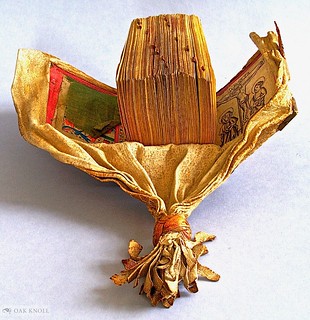
For more information, or to order, see:
THE MEDIEVAL GIRDLE BOOK.
(https://www.oakknoll.com/pages/books/129111/margit-smith/medieval-girdle-book-the)
GOLD COIN HOARD FOUND IN FOOD DONATION
 ANJA MASER, MANAGER OF THE Lindenhof Senior Center in Lürrip, Germany, was unpacking a box of donated food when she encountered a heavy box hidden below. Inside was—literally—treasure. The
box contained gold coins, 109 in total, featuring a springbok, South Africa’s national animal. A quick online search revealed that they were highly valuable Kruggerand bullion coins.
ANJA MASER, MANAGER OF THE Lindenhof Senior Center in Lürrip, Germany, was unpacking a box of donated food when she encountered a heavy box hidden below. Inside was—literally—treasure. The
box contained gold coins, 109 in total, featuring a springbok, South Africa’s national animal. A quick online search revealed that they were highly valuable Kruggerand bullion coins.
The Kruggerand—whose exchange rate is fixed daily and determined by the price of gold—was introduced in 1967, as a vehicle for the private ownership of gold after the demise of the gold standard. It became one of the most popular bullion coins—money minted to store value rather than to be used in day-to-day commerce—and by 1980 accounted for 90 percent of the global gold coin market.
Apart from its value and its connections to apartheid, the Krugerrand was an important numismatic innovation. “This was the first gold bullion coin introduced after gold coins had ceased to exist as currency,” says David Yoon of the American Numismatic Society. “Several other countries, including the U.S., Canada, Australia, and China now issue gold coins for the same reason—but South Africa was the first one.”
Today a single Krugerrand is worth approximately $1,300, so the coins that Maser found amount to a small fortune. Maser and he colleague Claudia Spetsmann contacted the police to try locate the donor of the box of food, and eventually reached a local, 78-year-old widow. “We knew absolutely nothing about her as the senior center only moved to Lürrip a few days ago,” Spetsman told the Rheinische Post. The woman was very grateful for the return of a treasure that her late husband had secreted away.
To read the complete article, see:
Found: A Fortune in Gold Coins in a Box of Donated Food
(https://www.atlasobscura.com/articles/found-gold-coins-box-donated-food-germany-returned)
HAVE A NUMISMATIC CHRISTMAS

To visit the Coin Rarities Online web site, see:
http://www.coinraritiesonline.com/
For more on The Man Who Invented Christmas, see:
THE MAN WHO INVENTED CHRISTMAS (2017) (https://www.rottentomatoes.com/m/the_man_who_invented_christmas/)
FEATURED WEB PAGE: OAK SAPLING ON GERMAN COINS
This week's Featured Web Page is from the Money Museum web site, an article about the Oak Sapling on 1950 German 50 Pfennig coins.When Germany laid in ashes, there was a need for new symbols indicating a fresh start. The mighty oak tree shrank to a little oak sprig held in her hands by a pregnant woman.
After the Allied victory of 1945, Germany was reduced to rubble.
The aerial bombardment by the enemy had almost completely destroyed all the larger German cities. Operation Gomorrah had claimed the lives of approximately 35,000 residents of Hamburg. In Pforzheim a third of the 65,000 residents died within 22 minutes. Overall, there were about half a million civilian deaths. And many more people were injured or made homeless.
The bombing, defeat and subsequent occupation had completely changed the self-image of an entire people. Where the Nazis had propagated the image of the German Übermensch, the humiliated losers felt only hunger, cold, and fear.
All the hope flourishing in Germany at that time was distilled in this small coin; the German 50 pfennig piece. Sculptor Richard Martin Werner provided the design. He used his then pregnant wife as a model. She is kneeling, and her clothing is reminiscent of the countless “Trümmerfrauen” who cleared Germany of rubble. However, the kneeling woman holds in her hand not a brick, but a small oak sapling with roots. A tiny little oak that she plants firmly in the earth, trusting in a new beginning.
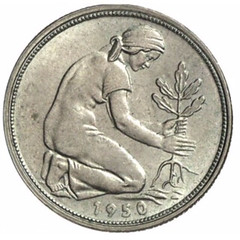
http://moneymuseum.com/en/coins/speaking-coins/
the-oak-as-symbol-of-growth-75

